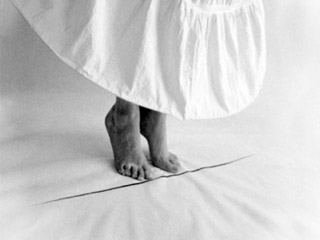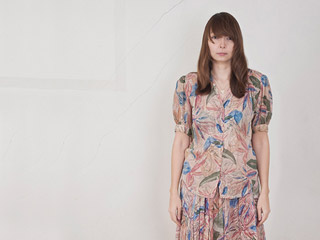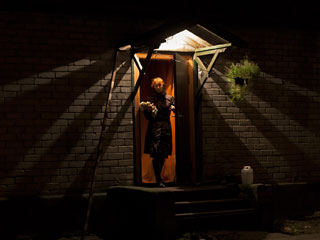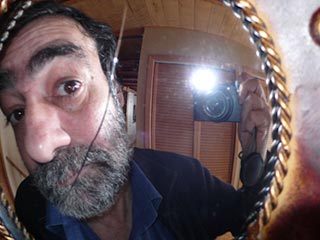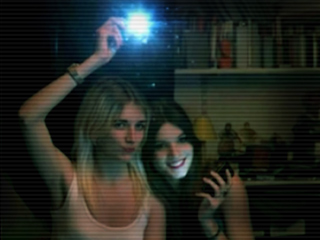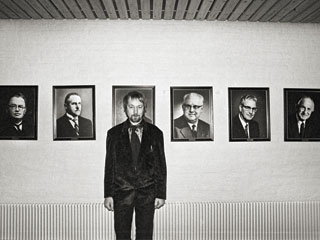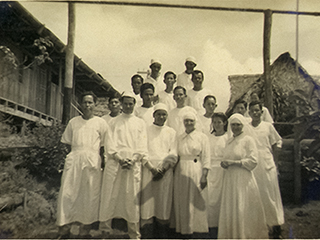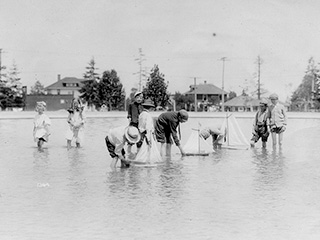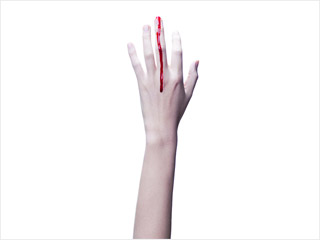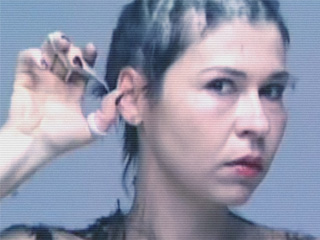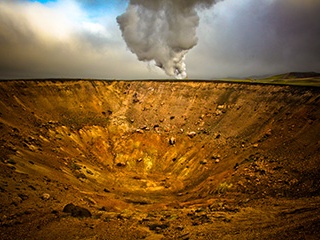Marta María Pérez
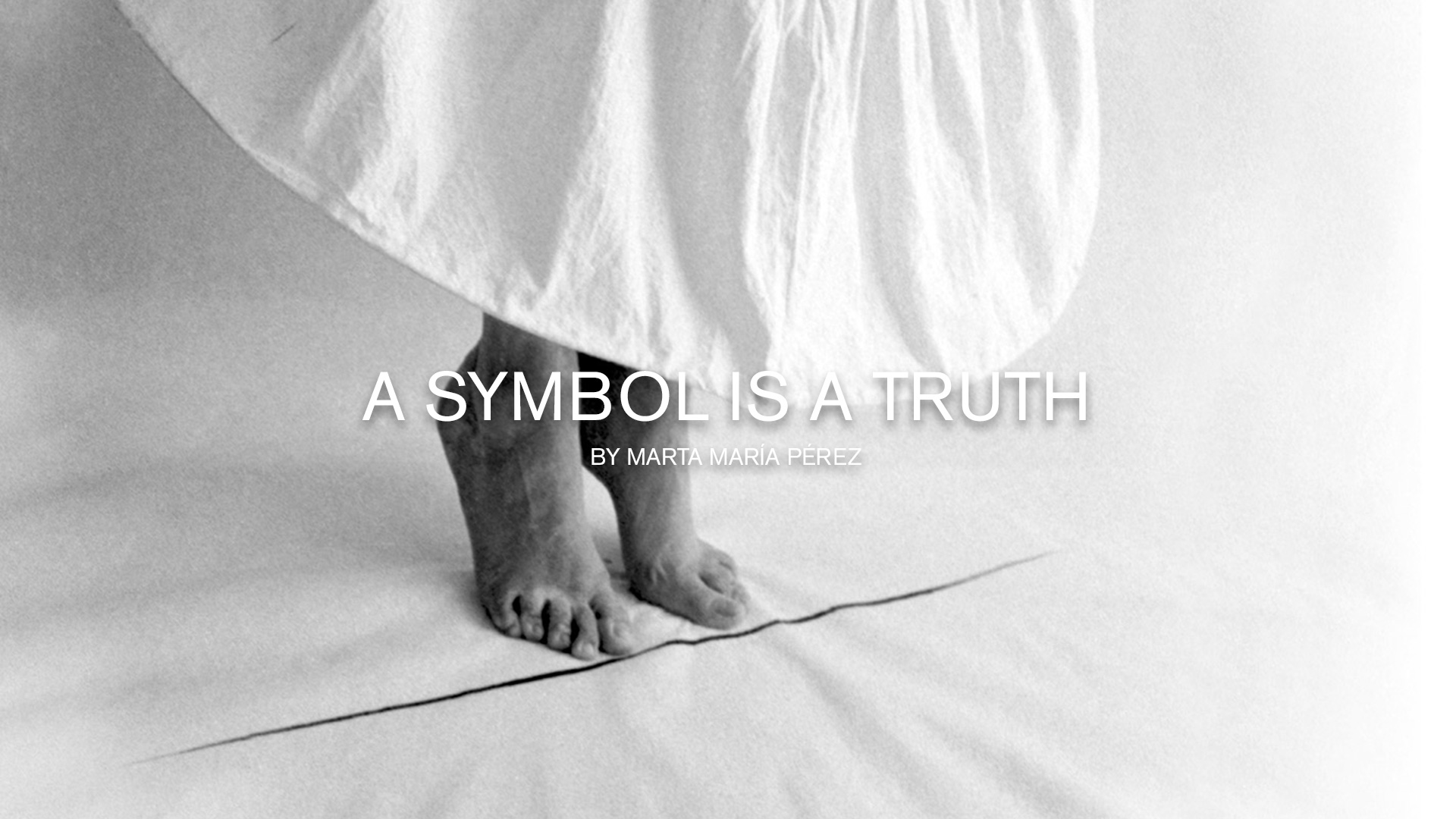
During a lifetime of work, Marta Maria Perez Bravo has explored the rites and beliefs of Cuban religion through her own image. Her body sacrifices the symbol, creating an account of intersections between dualities, such as the visible and the invisible, the material and the spiritual, life after death, the presence of absence. That reiteration of opposites uses its own aesthetic to create narratives that, supported by the photographic document, build a universe of re-creations of rites and ceremonial objects.
Currently, her artistic proposal has led her to use other visual mediums with which she complements and continues to investigate her conceptual interests.














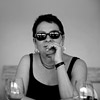 Marta María Pérez Bravo (Cuba, 1959). Lives and works in Mexico. Photographer. She began her studies as an artist in 1979 at the School of Visual Arts San Alejandro, Havana, Cuba. In 1984 she continued her studies at the Instituto Superior de Arte (ISA), Havana, Cuba. She has participated in numerous international solo and group exhibitions. She has won several awards for her work, such as the Guggenheim Fellowship (USA) in 1998.
Marta María Pérez Bravo (Cuba, 1959). Lives and works in Mexico. Photographer. She began her studies as an artist in 1979 at the School of Visual Arts San Alejandro, Havana, Cuba. In 1984 she continued her studies at the Instituto Superior de Arte (ISA), Havana, Cuba. She has participated in numerous international solo and group exhibitions. She has won several awards for her work, such as the Guggenheim Fellowship (USA) in 1998.ZZ. In your work, self-representation is a constant theme, ¿how did your interest in talking about various themes through your own image arise?
MM. I studied Fine Arts, but my graduate thesis, at the Instituto Superior de Arte in Havana (1984), was a photographic project, even though I never studied photography. This project consisted of photographs documenting actions that I performed outdoors, taking as its theme the popular superstitions regarding natural phenomena, appearances etc. When I was pregnant, I could no longer do these performances and I started using my own body. I started to document, in a different way, other actions related to these superstitions and popular beliefs, but now regarding my experience of motherhood. As in the first stage, these realities were constructed and ‘staged’. So, from the beginning, it was clear that using a model or another person, and not my own body would completely change the concept of the work, given that it has a strong autobiographical presence, although implicitly.
ZZ. We see that themes, like evocation and absence, are constant in your work. How have these themes continued to change throughout your career?
MM. In my work, religious themes, especially of afro-cuban origin, started to emerge. The constructed realities (constructed through the staged scenes), that are devoid of time and space, are re-creations (not recreations) of rites and ritual objects.
ZZ. What is the symbolic value of the objects in your photos? What place do you give to the objects as symbols in your photos? What does their reiterative use signify?
From the ritual objects I want to extract a meaning that goes beyond the form, though the making of these objects is done with reference to the originals and the use they are given in religious practices. Although my photography is always black and white, I use the original colors in the elaboration of these objects as a token of respect for these practices and real liturgical objects. Nevertheless, I don’t want the spectator to be distracted by these colors; I want him to focus his attention on the symbols and their meanings. Even though he might not know them at all (since they are object of separate study and profound analysis) my intention is that, when these symbols are interpreted, they evoke ideas and suggest and provoke sensations. In addition to this, the title is a fundamental part of each piece.
ZZ. How does photography help you in the search of your identity? And, what has the use of video added to your work?
Since the beginning of my work in the eighties, my work has been photographic, although five or six years ago it went through a formal change –not its concept nor its aesthetic– through the use of video. The only aspects that make these videos different from my photographic work is the existence of space and the time in which an action occurs. Besides that, my work has not changed; in representing my ideas, I maintain the minimalistic aesthetic, I use the same materials and concepts, I still use black and white and I don’t use audio.
I don’t exactly know in which moment I started using video, but I think it happened in a very natural way, or, in other words, the development of the work itself brought me to it. Actually, people had asked me why I didn’t make videos, because of the performative character of my work, but at the time I, as an artist, was not at all interested in the idea, even though later on I permanently incorporated this medium into my work.
ZZ. What has been the result of your search throughout these years and which course is it taking?
Currently I tend to use video as a medium and not photography, but I still maintain my own aesthetic and conceptual parameters. The only difference is that, at the moment, video is a perfect medium for what I want. Surely the development of my work will lead me to other formal solutions in the future.
I have always thought that maybe a lot of the success of an artist’s work depends on finding the right tool with which he can express and “realize” his ideas.

During a lifetime of work, Marta Maria Perez Bravo has explored the rites and beliefs of Cuban religion through her own image. Her body sacrifices the symbol, creating an account of intersections between dualities, such as the visible and the invisible, the material and the spiritual, life after death, the presence of absence. That reiteration of opposites uses its own aesthetic to create narratives that, supported by the photographic document, build a universe of re-creations of rites and ceremonial objects.
Currently, her artistic proposal has led her to use other visual mediums with which she complements and continues to investigate her conceptual interests.














 Marta María Pérez Bravo (Cuba, 1959). Lives and works in Mexico. Photographer. She began her studies as an artist in 1979 at the School of Visual Arts San Alejandro, Havana, Cuba. In 1984 she continued her studies at the Instituto Superior de Arte (ISA), Havana, Cuba. She has participated in numerous international solo and group exhibitions. She has won several awards for her work, such as the Guggenheim Fellowship (USA) in 1998.
Marta María Pérez Bravo (Cuba, 1959). Lives and works in Mexico. Photographer. She began her studies as an artist in 1979 at the School of Visual Arts San Alejandro, Havana, Cuba. In 1984 she continued her studies at the Instituto Superior de Arte (ISA), Havana, Cuba. She has participated in numerous international solo and group exhibitions. She has won several awards for her work, such as the Guggenheim Fellowship (USA) in 1998.ZZ. In your work, self-representation is a constant theme, ¿how did your interest in talking about various themes through your own image arise?
MM. I studied Fine Arts, but my graduate thesis, at the Instituto Superior de Arte in Havana (1984), was a photographic project, even though I never studied photography. This project consisted of photographs documenting actions that I performed outdoors, taking as its theme the popular superstitions regarding natural phenomena, appearances etc. When I was pregnant, I could no longer do these performances and I started using my own body. I started to document, in a different way, other actions related to these superstitions and popular beliefs, but now regarding my experience of motherhood. As in the first stage, these realities were constructed and ‘staged’. So, from the beginning, it was clear that using a model or another person, and not my own body would completely change the concept of the work, given that it has a strong autobiographical presence, although implicitly.
ZZ. We see that themes, like evocation and absence, are constant in your work. How have these themes continued to change throughout your career?
MM. In my work, religious themes, especially of afro-cuban origin, started to emerge. The constructed realities (constructed through the staged scenes), that are devoid of time and space, are re-creations (not recreations) of rites and ritual objects.
ZZ. What is the symbolic value of the objects in your photos? What place do you give to the objects as symbols in your photos? What does their reiterative use signify?
From the ritual objects I want to extract a meaning that goes beyond the form, though the making of these objects is done with reference to the originals and the use they are given in religious practices. Although my photography is always black and white, I use the original colors in the elaboration of these objects as a token of respect for these practices and real liturgical objects. Nevertheless, I don’t want the spectator to be distracted by these colors; I want him to focus his attention on the symbols and their meanings. Even though he might not know them at all (since they are object of separate study and profound analysis) my intention is that, when these symbols are interpreted, they evoke ideas and suggest and provoke sensations. In addition to this, the title is a fundamental part of each piece.
ZZ. How does photography help you in the search of your identity? And, what has the use of video added to your work?
Since the beginning of my work in the eighties, my work has been photographic, although five or six years ago it went through a formal change –not its concept nor its aesthetic– through the use of video. The only aspects that make these videos different from my photographic work is the existence of space and the time in which an action occurs. Besides that, my work has not changed; in representing my ideas, I maintain the minimalistic aesthetic, I use the same materials and concepts, I still use black and white and I don’t use audio.
I don’t exactly know in which moment I started using video, but I think it happened in a very natural way, or, in other words, the development of the work itself brought me to it. Actually, people had asked me why I didn’t make videos, because of the performative character of my work, but at the time I, as an artist, was not at all interested in the idea, even though later on I permanently incorporated this medium into my work.
ZZ. What has been the result of your search throughout these years and which course is it taking?
Currently I tend to use video as a medium and not photography, but I still maintain my own aesthetic and conceptual parameters. The only difference is that, at the moment, video is a perfect medium for what I want. Surely the development of my work will lead me to other formal solutions in the future.
I have always thought that maybe a lot of the success of an artist’s work depends on finding the right tool with which he can express and “realize” his ideas.
- Bidimensional by Liz Misterio
- Birthday Suits by Lucy Hilmer
- Caliber 45 by Nazareno Vidales
- Camila by Veronica Márquez
- Familial Ground by Rafael Goldchain
- Fine Art by Lissy Elle
- Pedro Meyer's Selfportraits. Curated by Vesta Mónica Herrerías
- Sexual Selection by Natasha Merritt
- Self-portrait by Jen Davis
- Selfportrait by Vivian Maier
- The autoportraits I y II by Kourtney Roy
- The Big Valley by Alex Prager
[core_state] => 1 [core_access] => 1 [core_metadata] => {"robots":"","author":"","rights":"","xreference":""} [core_created_user_id] => 838 [core_created_by_alias] => [core_created_time] => 2014-11-20 20:17:19 [core_images] => {"image_intro":"","float_intro":"","image_intro_alt":"","image_intro_caption":"","image_fulltext":"","float_fulltext":"","image_fulltext_alt":"","image_fulltext_caption":""} [core_modified_time] => 2015-09-30 17:48:39 [core_language] => en-GB [core_catid] => 47 [core_publish_up] => 2014-11-20 20:17:19 [core_publish_down] => 0000-00-00 00:00:00 [content_type_title] => Article [router] => ContentHelperRoute::getArticleRoute [author] => Elisa Rugo [author_email] => elisa@zonezero.com [link] => index.php?option=com_content&view=article&id=227:references&catid=47&lang=en-GB [displayDate] => 2014-11-20 20:17:19 [event] => stdClass Object ( [afterDisplayTitle] => [beforeDisplayContent] => [afterDisplayContent] => ) [text] =>- Bidimensional by Liz Misterio
- Birthday Suits by Lucy Hilmer
- Caliber 45 by Nazareno Vidales
- Camila by Veronica Márquez
- Familial Ground by Rafael Goldchain
- Fine Art by Lissy Elle
- Pedro Meyer's Selfportraits. Curated by Vesta Mónica Herrerías
- Sexual Selection by Natasha Merritt
- Self-portrait by Jen Davis
- Selfportrait by Vivian Maier
- The autoportraits I y II by Kourtney Roy
- The Big Valley by Alex Prager
[id] => 227 [language] => en-GB [catid] => 47 [jcfields] => Array ( ) ) 1Noah Kalina
Noah Kalina has been taking a photograph of himself every day since January 2000. Originally it was meant to be a photo project, but in 2006 he was inspired by a project by Ahree Lee, a graphic designer from California who had put a time-lapse video of herself on YouTube. Noah decided to do the same with his self-portraits and, within three weeks, it became an international internet sensation.
 Noah Kalina (US, 1980) is a photographer based in Brooklyn and Lumberland, New York. He graduated from the School of Visual Arts with a BFA in photography. His project ‘Everyday’ was a worldwide hit. His work has been exhibited all over the world: in the U.S., Switzerland, Italy, Belgium, France, Australia, England, Canada, Germany and the Netherlands. He also has given lectures in various countries. To see more of his work go to: noahkalina.com
Noah Kalina (US, 1980) is a photographer based in Brooklyn and Lumberland, New York. He graduated from the School of Visual Arts with a BFA in photography. His project ‘Everyday’ was a worldwide hit. His work has been exhibited all over the world: in the U.S., Switzerland, Italy, Belgium, France, Australia, England, Canada, Germany and the Netherlands. He also has given lectures in various countries. To see more of his work go to: noahkalina.comNoah Kalina has been taking a photograph of himself every day since January 2000. Originally it was meant to be a photo project, but in 2006 he was inspired by a project by Ahree Lee, a graphic designer from California who had put a time-lapse video of herself on YouTube. Noah decided to do the same with his self-portraits and, within three weeks, it became an international internet sensation.
 Noah Kalina (US, 1980) is a photographer based in Brooklyn and Lumberland, New York. He graduated from the School of Visual Arts with a BFA in photography. His project ‘Everyday’ was a worldwide hit. His work has been exhibited all over the world: in the U.S., Switzerland, Italy, Belgium, France, Australia, England, Canada, Germany and the Netherlands. He also has given lectures in various countries. To see more of his work go to: noahkalina.com
Noah Kalina (US, 1980) is a photographer based in Brooklyn and Lumberland, New York. He graduated from the School of Visual Arts with a BFA in photography. His project ‘Everyday’ was a worldwide hit. His work has been exhibited all over the world: in the U.S., Switzerland, Italy, Belgium, France, Australia, England, Canada, Germany and the Netherlands. He also has given lectures in various countries. To see more of his work go to: noahkalina.comKarolina Jonderko

I remember the joy of discovering Haribo jellies, Nutella and margarine among colorful clothes packed in heavy cardboard boxes we used to get from relatives who lived in West Germany, when Poland was lacking many basic things. It was a celebration, the whole family was present for these grand openings of gift boxes.
The clothes, mostly second-hand, were good enough for mother. She never felt the need to buy new ones, preferring to save money for more important expenses. She always looked modest and didn’t like black. Some say that what one wears is (a) part of creating one’s identity. My mother, all her life, wore clothes that she had never chosen.
On February 28, 2012, four years after her death, I started reliving the past. My work since then has been about building on my memories and longing. Self-Portrait With My Mother is an attempt to summarize that period, to move beyond the past -a final reconciliation with reality.
My grandmother’s house –where my mother, my sister and me (all) grew up– is empty and cold now, almost in ruins. This is where I’ve kept my mother’s clothes since she died. And now after my grandmother passed away, it’s where I’ve been making these self-portraits, recreating dresses and outfits from memory, like my mother used to match them. I recently tried on a different set of clothes that came in one of those big boxes many years ago. I found her blond hair on the green coat.

Home clothes. I remember her sitting at the piano, focused, her hand tapping the rhythm, patiently listening to the rattle of her students, and I can still hear her gentle voice: let’s repeat this fragment. How was she able to listen to that; I do not know till this day. My sister and I would leave the house after a few minutes.

Wedding clothes. I am 7 years old, the early nineties, cousin’s wedding, 150 guests; Most of them I don’t know. I am stuffing my mouth with a cake while watching my parents dancing to a bad version of Krawczyk’s song. My mother loved to dance and she was good at it. They looked great together, understanding without words. She did not like this type of feasts. Chatting with relatives, whom you see only at weddings and funerals. What to talk to them about? It’s much better to dance and send smiles.

Work clothes. Small, badly furnished office in No 2 Primary School, that both I and my sister attended. On the door “The Principal of After School Activities”. Mum at her desk, writing a report regarding achievements of "Alkatras"(a club for youngsters with problems) and “Orlik” (club for children and teenagers) for a meeting (meeting) with the town mayor. I'm waiting patiently in the corner; I want to walk home with her.

For the journey clothes. The departure day. Crowd on the platform. I am clasping my mum's and sister's hands. Suddenly I am rising. It's my mum passing me to my dad through the compartment's window. I am followed by two suitcases. My mum and sister somehow join us. It's crowded and stuffy and it will be like that for the next 14 hours. However, a 2 week seaside holiday is worth it. Mum has prepared sandwiches, hard-boiled eggs, tomatoes and tea in a 'Wyborowa' vodka bottle. We have 'Happy Minutes' ( a children's puzzle magazine in communist Poland). She loves the sea. She travels lost in her thoughts. I think she can already smell the sea and hear the waves and screeching seagulls. Her blue dress may be made from cheap material, but it doesn't crease and dries in 2 minutes - perfect for such journeys.

Christmas clothes. It’s Christmas Eve. Mom is busy in the kitchen, taking golden carp out of the oven carefully, to not stain herself with the hot butter. She is even wearing makeup, green, to match the outfit. She’s happy. She loves Christmas. After dinner, she is sitting at the piano and we all are singing Christmas carols.

Weekend clothes. Sunny day. The whole family sits in my grandmother’s garden, sausages on the grill, twittering birds, laughter, conversation. In this dress, my mother always smiled, relaxed. She wore it only on sunny days, free from work.

Kindergarten clothes. At the coal mine's kindergarten she would prepare the little ones for many performances. She would teach them songs about beloved mothers, the blackened faces of miners or brave marching Polish soldiers. She knew a song for every occasion. She wore blouses with big geometric patterns for the children. They loved her, the happy plump lady who, with rosy cheeks, accompanied their singing on the piano in front of their proud parents.

Sunday best clothes. It's Saint George's day. The whole family goes to the church fair. First we check out stands full of plastic toys, then the shooting range where dad manages to win mum a bunch of garish, fake flowers. Pink candy floss can't be missed. My sister and I have to stamp our feet to get it, as it's not healthy and bad for our teeth. But mum always gives in and on top of this grandma gives us two 'golden' rings with pink 'gems'. Total bliss. After the merry-go-round, we plead for one more go, just one more. And then we're going back, bangers going off in the background, mum, dad and grandma are happy, chatty; my sister is playing a toy whistle; and me with a mandatory baloon tied to my wrist.

Winter clothes. She would leave for work in darkness; we would all be still asleep. She would take a red bus to her work at the music school. We didn’t have a car. Waiting for the bus, bitter cold, the uncertainty whether it would come or not, shifting from foot to foot. On the way back she would do the shoppings. She would move slowly with the heavy bags, being careful not to slip. Freezing cold, with a red nose and cheeks, she would enter the house. Every night her soaked black boots would stand in a puddle of melted snow under a radiator in the kitchen.

Holiday clothes. It's summer. Apart from the intensively bright sun and the smell of freshly brewed coffee, mum's voice wakes us up. I have a quick peek through the curtains, the wash must have been hung outside early in the morning, it looks completely dry. I cannot see anyone, but I know she's there. I crane my neck and I am just able to make out blonde locks and cigarette smoke. The morning 'gossip' with the neighbours is in full swing. Bare-footed and in pyjamas my sister and I jump (out) on the balcony and join the discussion. We love summer. For two months we have our mum to ourselves, because of the summer holiday.
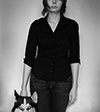 Karolina Jonderko (Poland, 1985). Lives and works in Poland. She graduated at the Silesian Voivedship Marshall in the field of culture and at Warsaw Film School. Currently Karolina is a student of photography at the Polish National Film, Television and Theatre School in Lodz. She has participated in various national and international exhibitions. Her works are based mostly on experiences and childhood memories. To see more of her work go to: karolinajonderko
Karolina Jonderko (Poland, 1985). Lives and works in Poland. She graduated at the Silesian Voivedship Marshall in the field of culture and at Warsaw Film School. Currently Karolina is a student of photography at the Polish National Film, Television and Theatre School in Lodz. She has participated in various national and international exhibitions. Her works are based mostly on experiences and childhood memories. To see more of her work go to: karolinajonderko[core_state] => 1 [core_access] => 1 [core_metadata] => {"robots":"","author":"Karolina Jonderko","rights":"","xreference":""} [core_created_user_id] => 838 [core_created_by_alias] => [core_created_time] => 2014-10-21 21:14:03 [core_images] => {"image_intro":"images\/categories\/liquididentity\/jordeko.jpg","float_intro":"","image_intro_alt":"","image_intro_caption":"","image_fulltext":"images\/categories\/liquididentity\/jordeko.jpg","float_fulltext":"","image_fulltext_alt":"","image_fulltext_caption":""} [core_modified_time] => 2015-09-30 17:48:39 [core_language] => en-GB [core_catid] => 47 [core_publish_up] => 2014-10-21 21:13:16 [core_publish_down] => 0000-00-00 00:00:00 [content_type_title] => Article [router] => ContentHelperRoute::getArticleRoute [author] => Elisa Rugo [author_email] => elisa@zonezero.com [link] => index.php?option=com_content&view=article&id=210:self-portrait-with-my-mother&catid=47&lang=en-GB [displayDate] => 2014-10-21 21:13:16 [event] => stdClass Object ( [afterDisplayTitle] => [beforeDisplayContent] => [afterDisplayContent] => ) [text] =>

I remember the joy of discovering Haribo jellies, Nutella and margarine among colorful clothes packed in heavy cardboard boxes we used to get from relatives who lived in West Germany, when Poland was lacking many basic things. It was a celebration, the whole family was present for these grand openings of gift boxes.
The clothes, mostly second-hand, were good enough for mother. She never felt the need to buy new ones, preferring to save money for more important expenses. She always looked modest and didn’t like black. Some say that what one wears is (a) part of creating one’s identity. My mother, all her life, wore clothes that she had never chosen.
On February 28, 2012, four years after her death, I started reliving the past. My work since then has been about building on my memories and longing. Self-Portrait With My Mother is an attempt to summarize that period, to move beyond the past -a final reconciliation with reality.
My grandmother’s house –where my mother, my sister and me (all) grew up– is empty and cold now, almost in ruins. This is where I’ve kept my mother’s clothes since she died. And now after my grandmother passed away, it’s where I’ve been making these self-portraits, recreating dresses and outfits from memory, like my mother used to match them. I recently tried on a different set of clothes that came in one of those big boxes many years ago. I found her blond hair on the green coat.

Home clothes. I remember her sitting at the piano, focused, her hand tapping the rhythm, patiently listening to the rattle of her students, and I can still hear her gentle voice: let’s repeat this fragment. How was she able to listen to that; I do not know till this day. My sister and I would leave the house after a few minutes.

Wedding clothes. I am 7 years old, the early nineties, cousin’s wedding, 150 guests; Most of them I don’t know. I am stuffing my mouth with a cake while watching my parents dancing to a bad version of Krawczyk’s song. My mother loved to dance and she was good at it. They looked great together, understanding without words. She did not like this type of feasts. Chatting with relatives, whom you see only at weddings and funerals. What to talk to them about? It’s much better to dance and send smiles.

Work clothes. Small, badly furnished office in No 2 Primary School, that both I and my sister attended. On the door “The Principal of After School Activities”. Mum at her desk, writing a report regarding achievements of "Alkatras"(a club for youngsters with problems) and “Orlik” (club for children and teenagers) for a meeting (meeting) with the town mayor. I'm waiting patiently in the corner; I want to walk home with her.

For the journey clothes. The departure day. Crowd on the platform. I am clasping my mum's and sister's hands. Suddenly I am rising. It's my mum passing me to my dad through the compartment's window. I am followed by two suitcases. My mum and sister somehow join us. It's crowded and stuffy and it will be like that for the next 14 hours. However, a 2 week seaside holiday is worth it. Mum has prepared sandwiches, hard-boiled eggs, tomatoes and tea in a 'Wyborowa' vodka bottle. We have 'Happy Minutes' ( a children's puzzle magazine in communist Poland). She loves the sea. She travels lost in her thoughts. I think she can already smell the sea and hear the waves and screeching seagulls. Her blue dress may be made from cheap material, but it doesn't crease and dries in 2 minutes - perfect for such journeys.

Christmas clothes. It’s Christmas Eve. Mom is busy in the kitchen, taking golden carp out of the oven carefully, to not stain herself with the hot butter. She is even wearing makeup, green, to match the outfit. She’s happy. She loves Christmas. After dinner, she is sitting at the piano and we all are singing Christmas carols.

Weekend clothes. Sunny day. The whole family sits in my grandmother’s garden, sausages on the grill, twittering birds, laughter, conversation. In this dress, my mother always smiled, relaxed. She wore it only on sunny days, free from work.

Kindergarten clothes. At the coal mine's kindergarten she would prepare the little ones for many performances. She would teach them songs about beloved mothers, the blackened faces of miners or brave marching Polish soldiers. She knew a song for every occasion. She wore blouses with big geometric patterns for the children. They loved her, the happy plump lady who, with rosy cheeks, accompanied their singing on the piano in front of their proud parents.

Sunday best clothes. It's Saint George's day. The whole family goes to the church fair. First we check out stands full of plastic toys, then the shooting range where dad manages to win mum a bunch of garish, fake flowers. Pink candy floss can't be missed. My sister and I have to stamp our feet to get it, as it's not healthy and bad for our teeth. But mum always gives in and on top of this grandma gives us two 'golden' rings with pink 'gems'. Total bliss. After the merry-go-round, we plead for one more go, just one more. And then we're going back, bangers going off in the background, mum, dad and grandma are happy, chatty; my sister is playing a toy whistle; and me with a mandatory baloon tied to my wrist.

Winter clothes. She would leave for work in darkness; we would all be still asleep. She would take a red bus to her work at the music school. We didn’t have a car. Waiting for the bus, bitter cold, the uncertainty whether it would come or not, shifting from foot to foot. On the way back she would do the shoppings. She would move slowly with the heavy bags, being careful not to slip. Freezing cold, with a red nose and cheeks, she would enter the house. Every night her soaked black boots would stand in a puddle of melted snow under a radiator in the kitchen.

Holiday clothes. It's summer. Apart from the intensively bright sun and the smell of freshly brewed coffee, mum's voice wakes us up. I have a quick peek through the curtains, the wash must have been hung outside early in the morning, it looks completely dry. I cannot see anyone, but I know she's there. I crane my neck and I am just able to make out blonde locks and cigarette smoke. The morning 'gossip' with the neighbours is in full swing. Bare-footed and in pyjamas my sister and I jump (out) on the balcony and join the discussion. We love summer. For two months we have our mum to ourselves, because of the summer holiday.
 Karolina Jonderko (Poland, 1985). Lives and works in Poland. She graduated at the Silesian Voivedship Marshall in the field of culture and at Warsaw Film School. Currently Karolina is a student of photography at the Polish National Film, Television and Theatre School in Lodz. She has participated in various national and international exhibitions. Her works are based mostly on experiences and childhood memories. To see more of her work go to: karolinajonderko
Karolina Jonderko (Poland, 1985). Lives and works in Poland. She graduated at the Silesian Voivedship Marshall in the field of culture and at Warsaw Film School. Currently Karolina is a student of photography at the Polish National Film, Television and Theatre School in Lodz. She has participated in various national and international exhibitions. Her works are based mostly on experiences and childhood memories. To see more of her work go to: karolinajonderko[id] => 210 [language] => en-GB [catid] => 47 [jcfields] => Array ( ) ) 1
Bahbak Hashemi-Nezhad

These images are the results of chance public encounters during a series of walks in Bolderaja, a largely Russian-speaking area of Riga which was industrialised and militarised during the soviet occupation.
Over three days in late November 2013, members of the public were requested to remotely photograph themselves and momentarily act out their everyday realities whilst continuing the situations in which they were encountered.
Set against new and yet to be completed housing developments, industrial estates, local businesses and suburban landscapes, these self-portraits act as vignettes, highlighting the roles the individuals play and the pleasures they experience in the public realm.


















The Riga Self-portraits were made in the context of the international community art project 'Contemporary Self-Portraits'. During this two-year project (September 2012–August 2014), self-portrait workshops were held in various European regions: Finland (Turku), Estonia (Tallinn), Ireland (Dublin), Latvia (Riga) and Sweden (Umeå).
The aim was to give local inhabitants a voice in expressing their personal and collective identity, as well as to encourage the development and sharing of communal art methodology and community development through arts.
The results were presented at exhibitions in each partner country and at a Final Symposium in Umea in 2014.
 Bahbak Hashemi-Nezhad (England, 1979). He graduated from the Royal College of Art in 2008 and founded a cross-disciplinary practice that has produced work ranging from product design, domestic and public spaces, photography, to food, games and public interventions. His practice is concerned with exploring the role of photography within design research, and with developing new design methodologies that actively engage individual users. bh-n.com
Bahbak Hashemi-Nezhad (England, 1979). He graduated from the Royal College of Art in 2008 and founded a cross-disciplinary practice that has produced work ranging from product design, domestic and public spaces, photography, to food, games and public interventions. His practice is concerned with exploring the role of photography within design research, and with developing new design methodologies that actively engage individual users. bh-n.com
These images are the results of chance public encounters during a series of walks in Bolderaja, a largely Russian-speaking area of Riga which was industrialised and militarised during the soviet occupation.
Over three days in late November 2013, members of the public were requested to remotely photograph themselves and momentarily act out their everyday realities whilst continuing the situations in which they were encountered.
Set against new and yet to be completed housing developments, industrial estates, local businesses and suburban landscapes, these self-portraits act as vignettes, highlighting the roles the individuals play and the pleasures they experience in the public realm.


















The Riga Self-portraits were made in the context of the international community art project 'Contemporary Self-Portraits'. During this two-year project (September 2012–August 2014), self-portrait workshops were held in various European regions: Finland (Turku), Estonia (Tallinn), Ireland (Dublin), Latvia (Riga) and Sweden (Umeå).
The aim was to give local inhabitants a voice in expressing their personal and collective identity, as well as to encourage the development and sharing of communal art methodology and community development through arts.
The results were presented at exhibitions in each partner country and at a Final Symposium in Umea in 2014.
 Bahbak Hashemi-Nezhad (England, 1979). He graduated from the Royal College of Art in 2008 and founded a cross-disciplinary practice that has produced work ranging from product design, domestic and public spaces, photography, to food, games and public interventions. His practice is concerned with exploring the role of photography within design research, and with developing new design methodologies that actively engage individual users. bh-n.com
Bahbak Hashemi-Nezhad (England, 1979). He graduated from the Royal College of Art in 2008 and founded a cross-disciplinary practice that has produced work ranging from product design, domestic and public spaces, photography, to food, games and public interventions. His practice is concerned with exploring the role of photography within design research, and with developing new design methodologies that actively engage individual users. bh-n.comTrish Morrissey

Front (2005-2007) deals with the notion of borders, boundaries and the edge, using the family group and the beach setting as metaphors. For this work, the artist travelled to beaches in the UK and around Melbourne. She approached families and groups of friends who had made temporary encampments, or marked out territories and asked if she could be part of their family temporarily. Morrissey then took over the role or position of a woman within that group - usually the mother figure. She asked to take her place, and to borrow her clothes. The woman then took over the artist's role and photographed her family using a 4x5 camera (which Morrissey had already carefully set up). While Morrissey, a stranger on the beach, nestled in with her loved ones. These highly performative photographs are shaped by chance encounters with strangers, and by what happens when physical and psychological boundaries are crossed. Ideas around the mythological creature the 'shape shifter' and the cuckoo are evoked. Each piece within the series is titled by the name of the woman who Morrissey replaced within the group.












 Trish Morrissey (Ireland, 1967). Lives and works in Dublin. She received a master´s degree in Photography from the University for Arts, London (2000-2001). She works with photography, film and video. She has participated in exhibitions around the world, including solo shows at Impressions Gallery, Bradford, UK; Pumphouse Gallery, London, UK; Yossi Milo Gallery, New York, USA; Gallery of Photography, Dublin, Ireland; and the Centre for Contemporary Photography, Melbourne, Australia. To see more of her work go to: trishmorrissey.
Trish Morrissey (Ireland, 1967). Lives and works in Dublin. She received a master´s degree in Photography from the University for Arts, London (2000-2001). She works with photography, film and video. She has participated in exhibitions around the world, including solo shows at Impressions Gallery, Bradford, UK; Pumphouse Gallery, London, UK; Yossi Milo Gallery, New York, USA; Gallery of Photography, Dublin, Ireland; and the Centre for Contemporary Photography, Melbourne, Australia. To see more of her work go to: trishmorrissey.ZZ. In the project Front you assume very diverse roles. How was it to adopt these different roles and to integrate yourself in such a way as to go unnoticed?
TM. The work was made over a 2 year period in which I became pregnant and had my first child, so my body shape was in constant flux. The period where I was obviously pregnant was over the winter, so no beach shots could be done, but I gained and lost 20kg (really!) which meant that my face changed a lot as well as my body. I think this helps the viewer assume they are seeing a different person in each picture on first viewing. It usually takes a while for them to realise it is the same person in each image. I also think that the language of photography is very familiar to everyone, even on a subconscious level. So when presented with a picture of 'a family' we have no reason to think that the photograph is anything else. People even see 'family resemblance' in these photographs where there is none. I also realised fairly early on in the process that in order to get people to receive my request to be part of an art project about families positively, I needed to already look like I was part of their tribe before I even approached them. If I didn't, then they usually rejected my request. So on my beach trips, I always carried a large bag of clothes. I would scout the beach quietly and pick a family who I wanted to work with, then change my clothes so that I would fit in before I approached them.
ZZ. Which aspects of your own identity do you find in each representation that you do of another person?
TM. I think it is no coincidence that I was newly pregnant when I started this project. In some ways, subconsiously I was 'trying on' motherhood, or in the pictures of groups of friends, I was imagining how life might carry on if I did not become a mother.
ZZ. Do you seek to provoke something in particular when you take people out of their context and replace them? How did people react to seeing themselves being replaced by you and to observe their lives from a distance, without them being present?
TM. I am using the beach as a metaphor for borders, boundaries and edges. The family unit has both physical and psychological boundaries, the beach is the border between culture and order (the land) and nature and chaos (the sea). By asking to be photographed with the family, and for the mother to come out of the picture and become the photographer, I am disrupting this boundary. It was a very strange feeling for the woman to do this, and I think because I was asking people who were more or less my own age and because I am a woman (I don't think a man would have the same success asking to be the father figure in the picture, and asking the man to step away from his family) and we had a rapport, the pictures were possible. One woman said 'Oh my God, it is as if I have died and my husband has a new wife!)

Front (2005-2007) deals with the notion of borders, boundaries and the edge, using the family group and the beach setting as metaphors. For this work, the artist travelled to beaches in the UK and around Melbourne. She approached families and groups of friends who had made temporary encampments, or marked out territories and asked if she could be part of their family temporarily. Morrissey then took over the role or position of a woman within that group - usually the mother figure. She asked to take her place, and to borrow her clothes. The woman then took over the artist's role and photographed her family using a 4x5 camera (which Morrissey had already carefully set up). While Morrissey, a stranger on the beach, nestled in with her loved ones. These highly performative photographs are shaped by chance encounters with strangers, and by what happens when physical and psychological boundaries are crossed. Ideas around the mythological creature the 'shape shifter' and the cuckoo are evoked. Each piece within the series is titled by the name of the woman who Morrissey replaced within the group.












 Trish Morrissey (Ireland, 1967). Lives and works in Dublin. She received a master´s degree in Photography from the University for Arts, London (2000-2001). She works with photography, film and video. She has participated in exhibitions around the world, including solo shows at Impressions Gallery, Bradford, UK; Pumphouse Gallery, London, UK; Yossi Milo Gallery, New York, USA; Gallery of Photography, Dublin, Ireland; and the Centre for Contemporary Photography, Melbourne, Australia. To see more of her work go to: trishmorrissey.
Trish Morrissey (Ireland, 1967). Lives and works in Dublin. She received a master´s degree in Photography from the University for Arts, London (2000-2001). She works with photography, film and video. She has participated in exhibitions around the world, including solo shows at Impressions Gallery, Bradford, UK; Pumphouse Gallery, London, UK; Yossi Milo Gallery, New York, USA; Gallery of Photography, Dublin, Ireland; and the Centre for Contemporary Photography, Melbourne, Australia. To see more of her work go to: trishmorrissey.ZZ. In the project Front you assume very diverse roles. How was it to adopt these different roles and to integrate yourself in such a way as to go unnoticed?
TM. The work was made over a 2 year period in which I became pregnant and had my first child, so my body shape was in constant flux. The period where I was obviously pregnant was over the winter, so no beach shots could be done, but I gained and lost 20kg (really!) which meant that my face changed a lot as well as my body. I think this helps the viewer assume they are seeing a different person in each picture on first viewing. It usually takes a while for them to realise it is the same person in each image. I also think that the language of photography is very familiar to everyone, even on a subconscious level. So when presented with a picture of 'a family' we have no reason to think that the photograph is anything else. People even see 'family resemblance' in these photographs where there is none. I also realised fairly early on in the process that in order to get people to receive my request to be part of an art project about families positively, I needed to already look like I was part of their tribe before I even approached them. If I didn't, then they usually rejected my request. So on my beach trips, I always carried a large bag of clothes. I would scout the beach quietly and pick a family who I wanted to work with, then change my clothes so that I would fit in before I approached them.
ZZ. Which aspects of your own identity do you find in each representation that you do of another person?
TM. I think it is no coincidence that I was newly pregnant when I started this project. In some ways, subconsiously I was 'trying on' motherhood, or in the pictures of groups of friends, I was imagining how life might carry on if I did not become a mother.
ZZ. Do you seek to provoke something in particular when you take people out of their context and replace them? How did people react to seeing themselves being replaced by you and to observe their lives from a distance, without them being present?
TM. I am using the beach as a metaphor for borders, boundaries and edges. The family unit has both physical and psychological boundaries, the beach is the border between culture and order (the land) and nature and chaos (the sea). By asking to be photographed with the family, and for the mother to come out of the picture and become the photographer, I am disrupting this boundary. It was a very strange feeling for the woman to do this, and I think because I was asking people who were more or less my own age and because I am a woman (I don't think a man would have the same success asking to be the father figure in the picture, and asking the man to step away from his family) and we had a rapport, the pictures were possible. One woman said 'Oh my God, it is as if I have died and my husband has a new wife!)
Vanessa Alcaíno & Elisa Rugo
That which I call my self-portrait is composed of thousands of days of work.
Each of them corresponds to the exact number and moment at which
I stopped as I painted after a task.
—Roman Opalka
Through the various forms of artistic expression over the last 500 years, the natural relationship born between the creator and his work tool has offered a rough testimony of self-exploration. We can see it from the self-portraits of Renaissance painters to the self-explorations produced by photographers opposite a mirror. The difference is that today we live in, thorough and for the image, and the image has driven us to communicate in a new way. Today, it has become a right to possess images of one’s self, and in this context the selfie appears to have emerged as a logical derivation of this human action.
Could we therefore consider selfies within the tradition of the self-portrait? Do they serve to search for, or develop, one’s identity? Let us begin with the idea that a selfie is not only a self-portrait in the traditional sense of the word. The selfie is created using a smart phone or webcam and places us in a spontaneous context or situation, showing its relative lack of preparation, but it also contains metadata that are commented on and shared repeatedly. This could define it as an emerging sub-genre of the self-portrait1, as taking this photographic image is in line with the new platforms of audiovisual communication.
However, the most appealing facet of this “new” trend is its social value. Current-day self-portraits do not seek to say this is me or this is how I am, as was done in times gone by to construct an identity, but rather they follow the logic of here I am or this is where I am. Being somewhere at a given moment prevails over just being. Persons therefore show themselves in a location, saying: this is where and how I am right now, with a mood: this is how I am today, or even, when in company: here I am with so-and-so. “Photography is not a memory, but an act”.2
The numerous self-portraits published every day construct visual diaries that show us multiple, plural and at the same time communal “private” stories. They are, in the digital era, the result of the democratization of the image, and acquire meaning once they are shared, not only among a specific group of persons (friends and/or relatives), but among all those who construct meaning through their interactions. The more active the exchange in networks, the stronger the links between their participants.
There are currently pages specializing in selfies that gather images in similar situations (selfiesatfunerals, selfieswithhomelesspeople, selfiesatseriousplaces, museumselfies.tumblr.com), projects that bring together collections of the (app.thefacesoffacebook, A través del espejo by Joan Fontcuberta), studies (selfiecity.net), new trends (Shaky Selfie), competitions, festivals (ClaroEcuador, Olimpiadas del selfie) and every day new apps appear that encourage us to tell a story by capturing images (Frontback). On many occasions film stars, musicians and celebrities such as the Pope or presidents express themselves through this medium, creating an intimate proximity with the public.
Taking photographs (of one’s self) has become an ordinary, everyday action. As Fontcuberta writes, it has become a compulsion. A vital compulsion in which each heartbeat becomes an image, such as the project The Whale Hunt, by Jonathan Harris, which uses 3,214 timed photographs to show in frequencies the most powerful moments of his experience of whale hunting. We are in an era that strives to photograph everything and create an interaction, in a context in which the photographic image has become a desire to speak. May nothing remain unrecorded or unshared! as we only exist insofar as we are present online.
What then of privacy? The intimate has become public. In 2000, a performance was presented called Nautilus, casa transparente.3 It consisted of a space with translucent walls in which a person was carrying out their daily life. People, some curious, others outraged, spend hours obsessively observing this person in his ordinary intimacy, as though he were an animal in a zoo. A few years later, and thanks to photography and its connectivity, we appear to be putting ourselves in this person’s place willingly and living in our own glass houses, exhibiting our everyday life without fear or prejudice.
Today’s democratized self-portrait is a public declaration carrying the message of our identity. The numerous devices and platforms used to communicate through the image enable us to react and create the need to leave a trace, in order for others to discover us. The selfie has become a social phenomenon of self-expression that can be as diverse as humanity itself, but we do not know to what extent social or cultural experiences are measured by the endless software. We are therefore invited to continue to take portraits of ourselves until technology becomes insufficient and we exceed the mobility, ubiquity and connection offered by the fifth moment of photography.4



























1 Tifentale, Alise. The Selfie: Making sense of the “Masturbation of Self-Image” and the “Virtual Mini-Me”. February 2014 / selfiecity.net
2 Fontcuberta, Joan. Quote from Joan Fontcuberta: el post-talento fotográfico. February 2014 by Galcerán de Born
3 Nautilus, casa transparente, an original idea by the Chilean architect Arturo Torres
4 The fifth momento of photography explores the effect of the iphone on photography, the technological 'mash-up' with the internet and omnipresent social connectivity. Edgar Gómez, and Eric T. Meyer. Creation and Control in the Photographic Process: iPhones and the Emerging Fifth Moment of Photography. Photographies 5, number 2 (2012): 203-221.
 Vanessa Alcaíno Pizani (Venezuela, 1980). Lives and works in Mexico. Visual artist. She graduated in Philosophy at the Central University of Venezuela and has a Master’s degree in Spanish and Latin American Thought at the Autonomous University of Madrid (UAM). Since 1994, she has worked in the field of photography at various institutions and organisations in Venezuela, Argentina and Mexico. At the moment, she is part of the editorial team of zonezero.com. You can see her work at: vanessapizani
Vanessa Alcaíno Pizani (Venezuela, 1980). Lives and works in Mexico. Visual artist. She graduated in Philosophy at the Central University of Venezuela and has a Master’s degree in Spanish and Latin American Thought at the Autonomous University of Madrid (UAM). Since 1994, she has worked in the field of photography at various institutions and organisations in Venezuela, Argentina and Mexico. At the moment, she is part of the editorial team of zonezero.com. You can see her work at: vanessapizani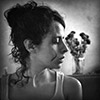 Elisa Rugo (Mexico, 1980). Lives and works in Mexico. She is a photographer, videographer and a specialist in visual communication with a degree in Creative Visualisation at the University of Communication. In 2012, she took part in the seminar Contemporary Photography at the Image Centre. She has participated in collective exhibitions in Pachuca, Querétaro, Guadalajara and Mexico-City. At the moment, she is the art director of the websites fpmeyer.com and museodemujeres.com and she is part of the editorial team of zonezero.com. You can see her work at: elisarugo.pro
Elisa Rugo (Mexico, 1980). Lives and works in Mexico. She is a photographer, videographer and a specialist in visual communication with a degree in Creative Visualisation at the University of Communication. In 2012, she took part in the seminar Contemporary Photography at the Image Centre. She has participated in collective exhibitions in Pachuca, Querétaro, Guadalajara and Mexico-City. At the moment, she is the art director of the websites fpmeyer.com and museodemujeres.com and she is part of the editorial team of zonezero.com. You can see her work at: elisarugo.proThat which I call my self-portrait is composed of thousands of days of work.
Each of them corresponds to the exact number and moment at which
I stopped as I painted after a task.
—Roman Opalka
Through the various forms of artistic expression over the last 500 years, the natural relationship born between the creator and his work tool has offered a rough testimony of self-exploration. We can see it from the self-portraits of Renaissance painters to the self-explorations produced by photographers opposite a mirror. The difference is that today we live in, thorough and for the image, and the image has driven us to communicate in a new way. Today, it has become a right to possess images of one’s self, and in this context the selfie appears to have emerged as a logical derivation of this human action.
Could we therefore consider selfies within the tradition of the self-portrait? Do they serve to search for, or develop, one’s identity? Let us begin with the idea that a selfie is not only a self-portrait in the traditional sense of the word. The selfie is created using a smart phone or webcam and places us in a spontaneous context or situation, showing its relative lack of preparation, but it also contains metadata that are commented on and shared repeatedly. This could define it as an emerging sub-genre of the self-portrait1, as taking this photographic image is in line with the new platforms of audiovisual communication.
However, the most appealing facet of this “new” trend is its social value. Current-day self-portraits do not seek to say this is me or this is how I am, as was done in times gone by to construct an identity, but rather they follow the logic of here I am or this is where I am. Being somewhere at a given moment prevails over just being. Persons therefore show themselves in a location, saying: this is where and how I am right now, with a mood: this is how I am today, or even, when in company: here I am with so-and-so. “Photography is not a memory, but an act”.2
The numerous self-portraits published every day construct visual diaries that show us multiple, plural and at the same time communal “private” stories. They are, in the digital era, the result of the democratization of the image, and acquire meaning once they are shared, not only among a specific group of persons (friends and/or relatives), but among all those who construct meaning through their interactions. The more active the exchange in networks, the stronger the links between their participants.
There are currently pages specializing in selfies that gather images in similar situations (selfiesatfunerals, selfieswithhomelesspeople, selfiesatseriousplaces, museumselfies.tumblr.com), projects that bring together collections of the (app.thefacesoffacebook, A través del espejo by Joan Fontcuberta), studies (selfiecity.net), new trends (Shaky Selfie), competitions, festivals (ClaroEcuador, Olimpiadas del selfie) and every day new apps appear that encourage us to tell a story by capturing images (Frontback). On many occasions film stars, musicians and celebrities such as the Pope or presidents express themselves through this medium, creating an intimate proximity with the public.
Taking photographs (of one’s self) has become an ordinary, everyday action. As Fontcuberta writes, it has become a compulsion. A vital compulsion in which each heartbeat becomes an image, such as the project The Whale Hunt, by Jonathan Harris, which uses 3,214 timed photographs to show in frequencies the most powerful moments of his experience of whale hunting. We are in an era that strives to photograph everything and create an interaction, in a context in which the photographic image has become a desire to speak. May nothing remain unrecorded or unshared! as we only exist insofar as we are present online.
What then of privacy? The intimate has become public. In 2000, a performance was presented called Nautilus, casa transparente.3 It consisted of a space with translucent walls in which a person was carrying out their daily life. People, some curious, others outraged, spend hours obsessively observing this person in his ordinary intimacy, as though he were an animal in a zoo. A few years later, and thanks to photography and its connectivity, we appear to be putting ourselves in this person’s place willingly and living in our own glass houses, exhibiting our everyday life without fear or prejudice.
Today’s democratized self-portrait is a public declaration carrying the message of our identity. The numerous devices and platforms used to communicate through the image enable us to react and create the need to leave a trace, in order for others to discover us. The selfie has become a social phenomenon of self-expression that can be as diverse as humanity itself, but we do not know to what extent social or cultural experiences are measured by the endless software. We are therefore invited to continue to take portraits of ourselves until technology becomes insufficient and we exceed the mobility, ubiquity and connection offered by the fifth moment of photography.4



























1 Tifentale, Alise. The Selfie: Making sense of the “Masturbation of Self-Image” and the “Virtual Mini-Me”. February 2014 / selfiecity.net
2 Fontcuberta, Joan. Quote from Joan Fontcuberta: el post-talento fotográfico. February 2014 by Galcerán de Born
3 Nautilus, casa transparente, an original idea by the Chilean architect Arturo Torres
4 The fifth momento of photography explores the effect of the iphone on photography, the technological 'mash-up' with the internet and omnipresent social connectivity. Edgar Gómez, and Eric T. Meyer. Creation and Control in the Photographic Process: iPhones and the Emerging Fifth Moment of Photography. Photographies 5, number 2 (2012): 203-221.
 Vanessa Alcaíno Pizani (Venezuela, 1980). Lives and works in Mexico. Visual artist. She graduated in Philosophy at the Central University of Venezuela and has a Master’s degree in Spanish and Latin American Thought at the Autonomous University of Madrid (UAM). Since 1994, she has worked in the field of photography at various institutions and organisations in Venezuela, Argentina and Mexico. At the moment, she is part of the editorial team of zonezero.com. You can see her work at: vanessapizani
Vanessa Alcaíno Pizani (Venezuela, 1980). Lives and works in Mexico. Visual artist. She graduated in Philosophy at the Central University of Venezuela and has a Master’s degree in Spanish and Latin American Thought at the Autonomous University of Madrid (UAM). Since 1994, she has worked in the field of photography at various institutions and organisations in Venezuela, Argentina and Mexico. At the moment, she is part of the editorial team of zonezero.com. You can see her work at: vanessapizani Elisa Rugo (Mexico, 1980). Lives and works in Mexico. She is a photographer, videographer and a specialist in visual communication with a degree in Creative Visualisation at the University of Communication. In 2012, she took part in the seminar Contemporary Photography at the Image Centre. She has participated in collective exhibitions in Pachuca, Querétaro, Guadalajara and Mexico-City. At the moment, she is the art director of the websites fpmeyer.com and museodemujeres.com and she is part of the editorial team of zonezero.com. You can see her work at: elisarugo.pro
Elisa Rugo (Mexico, 1980). Lives and works in Mexico. She is a photographer, videographer and a specialist in visual communication with a degree in Creative Visualisation at the University of Communication. In 2012, she took part in the seminar Contemporary Photography at the Image Centre. She has participated in collective exhibitions in Pachuca, Querétaro, Guadalajara and Mexico-City. At the moment, she is the art director of the websites fpmeyer.com and museodemujeres.com and she is part of the editorial team of zonezero.com. You can see her work at: elisarugo.proCatherine Balet
 Catherine Balet (France, 1959). Lives and works between Paris and Brighton. She graduated at the Ecole des Beaux Arts in Paris and worked as an artist before turning to Photography ten years ago. As a freelancer, she has been a regular contributor to various french and international magazines, also creating images for the world of fashion. She has today specialised in portraiture with an artistico-sociological approach of her subjects. To see more of her work go to: catherinebalet.
Catherine Balet (France, 1959). Lives and works between Paris and Brighton. She graduated at the Ecole des Beaux Arts in Paris and worked as an artist before turning to Photography ten years ago. As a freelancer, she has been a regular contributor to various french and international magazines, also creating images for the world of fashion. She has today specialised in portraiture with an artistico-sociological approach of her subjects. To see more of her work go to: catherinebalet.ZZ. Identity is an important theme in your work. How do you think identity is effected by the social media and new technologies?
CB. I am mainly interested in the quest for identity because it is a very revealing process of creativity and sociology. I try to depict young people in search of identity for the reason that teenagers are very innovative with the tools they use to express themselves. Ten years ago, I started a photographic series on the expression of identity through clothes, brands, trends and groups, as it was a very intense phenomenon at that time. This naturally brought me to technology, the devices having replaced the clothes as medium of self-expression. "Selfies" allow teenagers, who are going through the complex process of the creation of their identity, to be themselves and at the same time to be like the ones they admire. The disposable and renewable images they make of themselves are the best expression of the permanent changes they are experiencing. The fact that they can renew their profile and follow the group that they have chosen by conforming to codes of representation is essential in developing their identity. It allows them to validate their opinions and determine the appropriateness of their attitudes and behaviours. Teenagers have an enhanced need for self-presentation. Communicating their identity to others works as an act of auto-revelation. Mobile phones have become a sort of digital prosthesis which connects the "real me" to the "virtual me” through social networks, creating a double personality.
ZZ. I love myself, I love me, I do refers to the narcissistic self-awareness expressed on social networks. Do you consider 'the selfie' to be only a product of narcissism or do you think there is more to it?
CB. Narcissus was in love with himself and not looking for interaction. I think that taking a "selfie" is not a self-centred act but a way to become affiliated to a large universal community. "Selfies" are social portraits created in order to open up to others and to look for validation of one’s existence; questioning and looking for witnesses to confirm that you are doing the right thing. It’s more about taking part in a parallel and idealised world. The central quality of these self-images is that they are "shareable". Today, pictures have replaced words in an interactive conversation that is often full of humour and self-mockery.
ZZ. The video also refers to the new approach to quick, light mobile photography that affects our visual culture. What do you think of this development in visual culture?
CB. I did this video because I was interested in the new body attitude that "selfies" have established. It is about staging the photographic gesture itself, with the arm up and the mobile phone reflected in the mirror. The codes adopted in these photos are placed under the sign of a gestural performance.
Today, everyone who carries a phone also carries a camera. Photography has become so fundamental to the way we see things that "photography" and “seeing" could be used as synonyms nowadays. Instagram has made everyone into a photographer, as the devices offer the possibility of taking photos in practically any situation and light conditions. The improvements of technology allows us to take and retake "selfies" easily, until we are satisfied with the result, looking for the desired self in the right narrative and role. These huge amount of images have created a casual snap-shot aesthetic. Photography is not about framing and perspective any more. It has become so easy to produce an image of quality, while previously this was only possible with years of specialised training. The de-specialisation of photography questions what is worth paying attention to in these loads of images and what is going to stand the test of time? It also questions what will become of the traditional craft of photography. The very fact that a phone can be held in one hand makes it the perfect tool to capture something that is immediate, but it is not meant to create images that will resist the ravages of time.
ZZ. What effect did you want to create by relating classical painting to the contemporary digital world? Could you tell us something about the technique you used?
CB. I took the first image of the series Strangers in the light in 2008 as the digital light on people’s faces in the night fascinated me. There was a great pictorial beauty in this lighting and I became aware that these small technological lights were all over the world.
I thought that this technological glow created an aesthetic that suggested a connection to classical paintings and old masters. Thus I wished to amplify the feeling of a 21st century chiaroscuro. All the photos of the series are lit exclusively with the light of the devices. It invited me to investigate a reflection on the historic disruption that has been imposed by the invention of devices and question the ability of ubiquity that technology offers to each of us and how it has created today a world where we each live in a totally different space time as our ancestors. My characters stand in a compressed reality somewhere between past, present and future. They share fast, beautified moments in a world where speed has become the photographic priority and is changing the approach to time and memory.
For the video I love me, I love Myself, I do I wished to focus on the rhythm and frenetic obsession of short-lived "selfies". This is why I did it as a stop motion. I got my inspiration from Facebook where I noticed the teasing game of "show and hide" self-portraits, somewhere between total lack of modesty and a very strategic control of the limits of exhibitionism. My portraits are more like "twinnies" than "selfies" as I wanted them to express something about the staged relationship that is perceptible between the two characters. I whished to highlight the flashlight in the mirror, often burning the faces, as part of the scene. To take these portraits I stood in the dark with my models behind a glass pane and I used a low shutter speed to be able to capture the flash from my model’s camera.
Strangers in the light
 |
 |
 |
 |
 |
 Catherine Balet (France, 1959). Lives and works between Paris and Brighton. She graduated at the Ecole des Beaux Arts in Paris and worked as an artist before turning to Photography ten years ago. As a freelancer, she has been a regular contributor to various french and international magazines, also creating images for the world of fashion. She has today specialised in portraiture with an artistico-sociological approach of her subjects. To see more of her work go to: catherinebalet.
Catherine Balet (France, 1959). Lives and works between Paris and Brighton. She graduated at the Ecole des Beaux Arts in Paris and worked as an artist before turning to Photography ten years ago. As a freelancer, she has been a regular contributor to various french and international magazines, also creating images for the world of fashion. She has today specialised in portraiture with an artistico-sociological approach of her subjects. To see more of her work go to: catherinebalet.ZZ. Identity is an important theme in your work. How do you think identity is effected by the social media and new technologies?
CB. I am mainly interested in the quest for identity because it is a very revealing process of creativity and sociology. I try to depict young people in search of identity for the reason that teenagers are very innovative with the tools they use to express themselves. Ten years ago, I started a photographic series on the expression of identity through clothes, brands, trends and groups, as it was a very intense phenomenon at that time. This naturally brought me to technology, the devices having replaced the clothes as medium of self-expression. "Selfies" allow teenagers, who are going through the complex process of the creation of their identity, to be themselves and at the same time to be like the ones they admire. The disposable and renewable images they make of themselves are the best expression of the permanent changes they are experiencing. The fact that they can renew their profile and follow the group that they have chosen by conforming to codes of representation is essential in developing their identity. It allows them to validate their opinions and determine the appropriateness of their attitudes and behaviours. Teenagers have an enhanced need for self-presentation. Communicating their identity to others works as an act of auto-revelation. Mobile phones have become a sort of digital prosthesis which connects the "real me" to the "virtual me” through social networks, creating a double personality.
ZZ. I love myself, I love me, I do refers to the narcissistic self-awareness expressed on social networks. Do you consider 'the selfie' to be only a product of narcissism or do you think there is more to it?
CB. Narcissus was in love with himself and not looking for interaction. I think that taking a "selfie" is not a self-centred act but a way to become affiliated to a large universal community. "Selfies" are social portraits created in order to open up to others and to look for validation of one’s existence; questioning and looking for witnesses to confirm that you are doing the right thing. It’s more about taking part in a parallel and idealised world. The central quality of these self-images is that they are "shareable". Today, pictures have replaced words in an interactive conversation that is often full of humour and self-mockery.
ZZ. The video also refers to the new approach to quick, light mobile photography that affects our visual culture. What do you think of this development in visual culture?
CB. I did this video because I was interested in the new body attitude that "selfies" have established. It is about staging the photographic gesture itself, with the arm up and the mobile phone reflected in the mirror. The codes adopted in these photos are placed under the sign of a gestural performance.
Today, everyone who carries a phone also carries a camera. Photography has become so fundamental to the way we see things that "photography" and “seeing" could be used as synonyms nowadays. Instagram has made everyone into a photographer, as the devices offer the possibility of taking photos in practically any situation and light conditions. The improvements of technology allows us to take and retake "selfies" easily, until we are satisfied with the result, looking for the desired self in the right narrative and role. These huge amount of images have created a casual snap-shot aesthetic. Photography is not about framing and perspective any more. It has become so easy to produce an image of quality, while previously this was only possible with years of specialised training. The de-specialisation of photography questions what is worth paying attention to in these loads of images and what is going to stand the test of time? It also questions what will become of the traditional craft of photography. The very fact that a phone can be held in one hand makes it the perfect tool to capture something that is immediate, but it is not meant to create images that will resist the ravages of time.
ZZ. What effect did you want to create by relating classical painting to the contemporary digital world? Could you tell us something about the technique you used?
CB. I took the first image of the series Strangers in the light in 2008 as the digital light on people’s faces in the night fascinated me. There was a great pictorial beauty in this lighting and I became aware that these small technological lights were all over the world.
I thought that this technological glow created an aesthetic that suggested a connection to classical paintings and old masters. Thus I wished to amplify the feeling of a 21st century chiaroscuro. All the photos of the series are lit exclusively with the light of the devices. It invited me to investigate a reflection on the historic disruption that has been imposed by the invention of devices and question the ability of ubiquity that technology offers to each of us and how it has created today a world where we each live in a totally different space time as our ancestors. My characters stand in a compressed reality somewhere between past, present and future. They share fast, beautified moments in a world where speed has become the photographic priority and is changing the approach to time and memory.
For the video I love me, I love Myself, I do I wished to focus on the rhythm and frenetic obsession of short-lived "selfies". This is why I did it as a stop motion. I got my inspiration from Facebook where I noticed the teasing game of "show and hide" self-portraits, somewhere between total lack of modesty and a very strategic control of the limits of exhibitionism. My portraits are more like "twinnies" than "selfies" as I wanted them to express something about the staged relationship that is perceptible between the two characters. I whished to highlight the flashlight in the mirror, often burning the faces, as part of the scene. To take these portraits I stood in the dark with my models behind a glass pane and I used a low shutter speed to be able to capture the flash from my model’s camera.
Strangers in the light
 |
 |
 |
 |
 |
ZoneZero
With the immediacy and extensive use of devices and techniques, the theme of self-representation has suffered fundamental changes that redefine its uses, processes and discourse. Identity has become fluid: it is no longer limited to just one definition and one direction, but is it changeable, dynamic, and is being represented in infinite ways.
Under this premise ZoneZero invites all persons interested in photographic creation to participate in an exercise of self-representation. We will discover other ways of showing ourselves to the world using the possibilities of the image.
Rules:
- You must send a series of three photographs that redefine your identity
- To participate, use the hashtag #ZZ3Me on the following social networks: Twitter, Instagram or use the form in this open call. (If you want to participate through Instagram, you must have a public account)
- You must be the author of the photographs
- In the same post, please tell us something about how you made the series and why you consider yourself to be exploring new forms of self-representation
- By participating, you authorise the publication of the image(s) on our website
This call for submissions is open from its publication until November, 10. As of October 10, you will be able to check out the latest posts with the hashtag #ZZ3Me on this page.
By participating, you join the open dialogue and reflection on the many ways of producing photography.
Please participate! We look forward to seeing your proposals!
Best wishes,
ZoneZero Team
Upload 3 images (750 Kb max size)
{chronoforms5}ZONEZERO{/chronoforms5}
[core_state] => 1 [core_access] => 1 [core_metadata] => {"robots":"","author":"ZoneZero","rights":"","xreference":""} [core_created_user_id] => 838 [core_created_by_alias] => [core_created_time] => 2014-09-24 21:00:34 [core_images] => {"image_intro":"images\/categories\/liquididentity\/zz3me.jpg","float_intro":"","image_intro_alt":"","image_intro_caption":"","image_fulltext":"images\/categories\/liquididentity\/zz3me.jpg","float_fulltext":"","image_fulltext_alt":"","image_fulltext_caption":""} [core_modified_time] => 2015-09-30 17:48:39 [core_language] => en-GB [core_catid] => 47 [core_publish_up] => 2014-09-24 21:00:31 [core_publish_down] => 0000-00-00 00:00:00 [content_type_title] => Article [router] => ContentHelperRoute::getArticleRoute [author] => Elisa Rugo [author_email] => elisa@zonezero.com [link] => index.php?option=com_content&view=article&id=200:three-ways-to-be-you&catid=47&lang=en-GB [displayDate] => 2014-09-24 21:00:31 [event] => stdClass Object ( [afterDisplayTitle] => [beforeDisplayContent] => [afterDisplayContent] => ) [text] =>
With the immediacy and extensive use of devices and techniques, the theme of self-representation has suffered fundamental changes that redefine its uses, processes and discourse. Identity has become fluid: it is no longer limited to just one definition and one direction, but is it changeable, dynamic, and is being represented in infinite ways.
Under this premise ZoneZero invites all persons interested in photographic creation to participate in an exercise of self-representation. We will discover other ways of showing ourselves to the world using the possibilities of the image.
Rules:
- You must send a series of three photographs that redefine your identity
- To participate, use the hashtag #ZZ3Me on the following social networks: Twitter, Instagram or use the form in this open call. (If you want to participate through Instagram, you must have a public account)
- You must be the author of the photographs
- In the same post, please tell us something about how you made the series and why you consider yourself to be exploring new forms of self-representation
- By participating, you authorise the publication of the image(s) on our website
This call for submissions is open from its publication until November, 10. As of October 10, you will be able to check out the latest posts with the hashtag #ZZ3Me on this page.
By participating, you join the open dialogue and reflection on the many ways of producing photography.
Please participate! We look forward to seeing your proposals!
Best wishes,
ZoneZero Team
Upload 3 images (750 Kb max size)
{chronoforms5}ZONEZERO{/chronoforms5}
[id] => 200 [language] => en-GB [catid] => 47 [jcfields] => Array ( ) ) 1
Bruno Bresani






















 Bruno Bresani (Brasil, 1973). Lives and works in Mexico. Photographer. He has completed three masters: Production and Artistic Research at the University of Barcelona, Digital Arts at the University Pompeu Fabra and Visual Arts at the National School of Plastic Arts at the UNAM. He has participated in several festivals and exhibitions in various cities in Mexico, the United Kingdom, Portugal, Austria, Argentina, Colombia, Morocco, Cuba and Spain. To see more of his work go to: brunobresani.blogspot.mx/
Bruno Bresani (Brasil, 1973). Lives and works in Mexico. Photographer. He has completed three masters: Production and Artistic Research at the University of Barcelona, Digital Arts at the University Pompeu Fabra and Visual Arts at the National School of Plastic Arts at the UNAM. He has participated in several festivals and exhibitions in various cities in Mexico, the United Kingdom, Portugal, Austria, Argentina, Colombia, Morocco, Cuba and Spain. To see more of his work go to: brunobresani.blogspot.mx/





















 Bruno Bresani (Brasil, 1973). Lives and works in Mexico. Photographer. He has completed three masters: Production and Artistic Research at the University of Barcelona, Digital Arts at the University Pompeu Fabra and Visual Arts at the National School of Plastic Arts at the UNAM. He has participated in several festivals and exhibitions in various cities in Mexico, the United Kingdom, Portugal, Austria, Argentina, Colombia, Morocco, Cuba and Spain. To see more of his work go to: brunobresani.blogspot.mx/
Bruno Bresani (Brasil, 1973). Lives and works in Mexico. Photographer. He has completed three masters: Production and Artistic Research at the University of Barcelona, Digital Arts at the University Pompeu Fabra and Visual Arts at the National School of Plastic Arts at the UNAM. He has participated in several festivals and exhibitions in various cities in Mexico, the United Kingdom, Portugal, Austria, Argentina, Colombia, Morocco, Cuba and Spain. To see more of his work go to: brunobresani.blogspot.mx/Claire Gilliam


In 2012, I stepped out from behind the camera and, in the dark, placed my body onto photographic paper. In a few brief seconds of illumination, I left my mark. Made as if by magic through an alchemy of silver and light, here was evidence of my presence, witness to my physical self at a particular time and space. This fascination with the physical body, its sensations, its wholeness and with the traces we leave behind, stem from my own experience of having lived within a disabled body my whole life, learning to live with my own set of limitations and peculiarities, my own truths and fantasies.
I was inspired to make my large photograms after discovering small photograms of my hands and feet I had made many years ago (1996/97), during my Fine Art degree at Sheffield Hallam University in England. They had been made as part of a larger installation piece where I recreated the hospital spaces I had spent so much time visiting as a child. The linoleum floors, long corridors and bare walls I erected had the traces of myself in the form of these photograms laid down with liquid light.
Each photogram is a unique gelatin silver print made on semi-matt paper and toned in gold. I make the pieces in one step, by placing the sheets of photographic paper onto the floor of my darkened studio and laying vellum paper with my thoughts and words, relating to the experience of the body written upon them, some very personal others more general, on top of it. I use a strobe as my light source as I move across the paper to record my presence and then develop it in the darkroom. The resulting images are one of a kind pieces which I then tone with gold.
Although these photograms are unique in one sense, there is the feeling contained within these images, that my experience is one which is shared by everybody, mirroring the strange, puzzling and transient experience of the human body in each of the spaces we occupy.









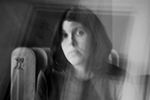 Claire Gilliam (England, 1979). Lives and works in the United States since 1999. In 1997 she graduated form Sheffield Hallam University, UK with a Bachelor in Fine Arts and 2000 she completed the Professional Certificate in Photography at Rockport College, Maine. She has participated in the Independent Project Seminar at ICP in New York. Her work has been shown in Europe and the USA and is held in several private and public collections, including the ICP Library Print collection. To see more of her work go to: clairegilliam.com
Claire Gilliam (England, 1979). Lives and works in the United States since 1999. In 1997 she graduated form Sheffield Hallam University, UK with a Bachelor in Fine Arts and 2000 she completed the Professional Certificate in Photography at Rockport College, Maine. She has participated in the Independent Project Seminar at ICP in New York. Her work has been shown in Europe and the USA and is held in several private and public collections, including the ICP Library Print collection. To see more of her work go to: clairegilliam.com

In 2012, I stepped out from behind the camera and, in the dark, placed my body onto photographic paper. In a few brief seconds of illumination, I left my mark. Made as if by magic through an alchemy of silver and light, here was evidence of my presence, witness to my physical self at a particular time and space. This fascination with the physical body, its sensations, its wholeness and with the traces we leave behind, stem from my own experience of having lived within a disabled body my whole life, learning to live with my own set of limitations and peculiarities, my own truths and fantasies.
I was inspired to make my large photograms after discovering small photograms of my hands and feet I had made many years ago (1996/97), during my Fine Art degree at Sheffield Hallam University in England. They had been made as part of a larger installation piece where I recreated the hospital spaces I had spent so much time visiting as a child. The linoleum floors, long corridors and bare walls I erected had the traces of myself in the form of these photograms laid down with liquid light.
Each photogram is a unique gelatin silver print made on semi-matt paper and toned in gold. I make the pieces in one step, by placing the sheets of photographic paper onto the floor of my darkened studio and laying vellum paper with my thoughts and words, relating to the experience of the body written upon them, some very personal others more general, on top of it. I use a strobe as my light source as I move across the paper to record my presence and then develop it in the darkroom. The resulting images are one of a kind pieces which I then tone with gold.
Although these photograms are unique in one sense, there is the feeling contained within these images, that my experience is one which is shared by everybody, mirroring the strange, puzzling and transient experience of the human body in each of the spaces we occupy.









 Claire Gilliam (England, 1979). Lives and works in the United States since 1999. In 1997 she graduated form Sheffield Hallam University, UK with a Bachelor in Fine Arts and 2000 she completed the Professional Certificate in Photography at Rockport College, Maine. She has participated in the Independent Project Seminar at ICP in New York. Her work has been shown in Europe and the USA and is held in several private and public collections, including the ICP Library Print collection. To see more of her work go to: clairegilliam.com
Claire Gilliam (England, 1979). Lives and works in the United States since 1999. In 1997 she graduated form Sheffield Hallam University, UK with a Bachelor in Fine Arts and 2000 she completed the Professional Certificate in Photography at Rockport College, Maine. She has participated in the Independent Project Seminar at ICP in New York. Her work has been shown in Europe and the USA and is held in several private and public collections, including the ICP Library Print collection. To see more of her work go to: clairegilliam.comAlejandro Malo
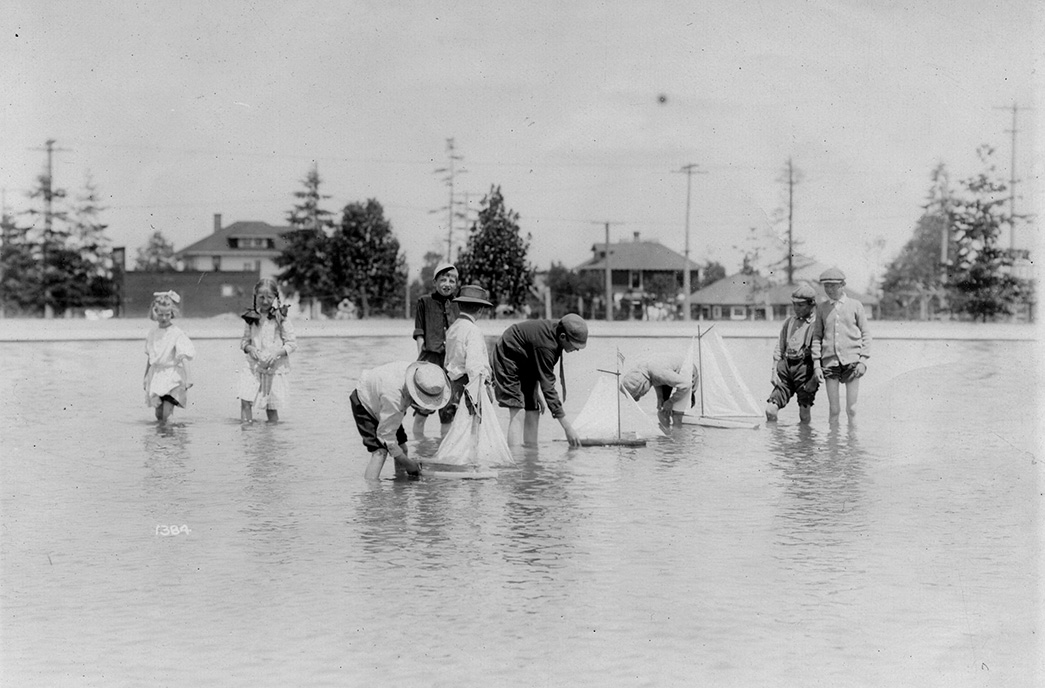
Hiawatha Playfield wading pool, 1912. Don Sherwood Parks History Collection (Record Series 5801-01), Seattle Municipal Archives.
Until a few centuries ago, one’s own image, clear and individual, was an experience many people could only achieve when they gazed at a mirror of water. It is no coincidence that, while Balzac and Dickens were recovering all types of characters from anonymity, technology made mirrors affordable and photography emerged from laboratories. The need arose to recognize one’s self. Suddenly, presenting one’s self and surviving in an image was available to more people, as demonstrated by the business cards popularized by Disdéri in France and Victorian post-mortem photography.
Nonetheless, the concept of identity was gradually constructed and consolidated throughout the 20th century, from various fronts, accompanied by photography. Identity documents and passports, the evolution of cameras, the growing visual recognition and recording of minorities all led to the current possibility of determining for ourselves not so much who we are, but how we wish to be seen. A few years ago, students were typically asked: what do you want to be when you grow up? Today, with photography linked to social networks, many young persons are constantly reporting who they are, and do not have to wait for an uncertain definitive vision of themselves, which technology makes impossible. More and more people, in response to an environment that is changing at breakneck speed, must repeatedly adapt to an identity that assumes the shape of its opportunities, and benefits as much as possible from its learning capacity.
Where there is life, identity cannot be carved in stone. It has now become liquid and we will have increasing opportunities and challenges to guide its flow. Confronted with the risk of our own face slipping out of our hands in the immense torrent of memes, filters and recreations that enable the digital world and facilitate social networks, it is important to know how other persons have channeled their means of depicting themselves. There is an inexhaustible ocean of images for this topic, from which we have selected a small sample that enable us to explore this horizon. This phenomenon, and its most recent evolution, is such a vast sphere that it is barely possible to scratch the surface, but we wish to share this journey with you.
 Alejandro Malo (Mexico, 1972). Lives and works in Mexico and is the director of ZoneZero. Since 1993, he has taken part in various cultural projects and worked as an information technology consultant. He has collaborated in print and electronic publications, and given workshops and conferences on literature, creative writing, storytelling and technology. In 2009, Malo joined the team of the Fundación Pedro Meyer, where he directs the Archives and Technology departments.
Alejandro Malo (Mexico, 1972). Lives and works in Mexico and is the director of ZoneZero. Since 1993, he has taken part in various cultural projects and worked as an information technology consultant. He has collaborated in print and electronic publications, and given workshops and conferences on literature, creative writing, storytelling and technology. In 2009, Malo joined the team of the Fundación Pedro Meyer, where he directs the Archives and Technology departments.
Hiawatha Playfield wading pool, 1912. Don Sherwood Parks History Collection (Record Series 5801-01), Seattle Municipal Archives.
Until a few centuries ago, one’s own image, clear and individual, was an experience many people could only achieve when they gazed at a mirror of water. It is no coincidence that, while Balzac and Dickens were recovering all types of characters from anonymity, technology made mirrors affordable and photography emerged from laboratories. The need arose to recognize one’s self. Suddenly, presenting one’s self and surviving in an image was available to more people, as demonstrated by the business cards popularized by Disdéri in France and Victorian post-mortem photography.
Nonetheless, the concept of identity was gradually constructed and consolidated throughout the 20th century, from various fronts, accompanied by photography. Identity documents and passports, the evolution of cameras, the growing visual recognition and recording of minorities all led to the current possibility of determining for ourselves not so much who we are, but how we wish to be seen. A few years ago, students were typically asked: what do you want to be when you grow up? Today, with photography linked to social networks, many young persons are constantly reporting who they are, and do not have to wait for an uncertain definitive vision of themselves, which technology makes impossible. More and more people, in response to an environment that is changing at breakneck speed, must repeatedly adapt to an identity that assumes the shape of its opportunities, and benefits as much as possible from its learning capacity.
Where there is life, identity cannot be carved in stone. It has now become liquid and we will have increasing opportunities and challenges to guide its flow. Confronted with the risk of our own face slipping out of our hands in the immense torrent of memes, filters and recreations that enable the digital world and facilitate social networks, it is important to know how other persons have channeled their means of depicting themselves. There is an inexhaustible ocean of images for this topic, from which we have selected a small sample that enable us to explore this horizon. This phenomenon, and its most recent evolution, is such a vast sphere that it is barely possible to scratch the surface, but we wish to share this journey with you.
 Alejandro Malo (Mexico, 1972). Lives and works in Mexico and is the director of ZoneZero. Since 1993, he has taken part in various cultural projects and worked as an information technology consultant. He has collaborated in print and electronic publications, and given workshops and conferences on literature, creative writing, storytelling and technology. In 2009, Malo joined the team of the Fundación Pedro Meyer, where he directs the Archives and Technology departments.
Alejandro Malo (Mexico, 1972). Lives and works in Mexico and is the director of ZoneZero. Since 1993, he has taken part in various cultural projects and worked as an information technology consultant. He has collaborated in print and electronic publications, and given workshops and conferences on literature, creative writing, storytelling and technology. In 2009, Malo joined the team of the Fundación Pedro Meyer, where he directs the Archives and Technology departments.Pyuupiru
The search of an ideal self
by Annemarie Bas
Speaking of the theme of this issue, Liquid Identity, one could say Pyuupiru is its embodiment. She was born as a male, but gradually realised that she didn’t feel comfortable with her body. She started wearing eccentric costumes that distorted her figure. And in 2007 she decided to take it a step further and get sex reassignment surgery, an experience that inspired her Self-portrait Series.
Identity, for Pyuupiru, is something that is constantly being developed and changed. In an interview she said:
“As time goes by, we grow both qualitatively and quantitatively, expanding our capacity. We continue to add various elements and new points of view to our personality, until we are like a bunch of grapes. I think this is the life of people from birth to death.”1
In this way, identity is not a fixed quality, one is constantly adding new elements to one’s personality, moulding it, giving it a new shape, perfecting it, searching for an ideal self. This process is not limited to the mind. The body can also be reshaped, so that it is in harmony with one’s identity.
Pyuupiru described the relationship between body and identity as follows:
“For me, the body is like a vase made of fragile glass. Liquid is an emotion of various colours poured in the vase, and identity is a will to make one pour the liquid into it. You know that the glass changes its shape when heat is added. And you know you choose what you wear by your will. Just like that I’ve transformed my body by my will, both internally and externally. It required me to reveal my very emotion. Emotion is just like a heat having various temperatures, and everyone has it.”2
The discord between body and mind, that Pyuupiru had felt since childhood, has been an incentive for her to make art. In her artistic work, her life experiences and emotions are vital. She keeps them bottled inside of her until they boil, provoking a creative explosion which is then transformed into art.
When she made the Self-portrait Series, she thought of the oppression she felt due to her gender dilemmas: first she thought of her memories and experiences of pain, such as her memories of boyhood and the nightmares caused by hormone replacement therapy and psychoactive drugs. She focused on them up to the point where she felt she had re-lived the suffering enough. Then she filtered those memories and experiences through her sense of beauty in order to be able to shape the characters in her work from the inside and the outside. After that, Pyuupiru, photographed and materialised these characters.
The result is a series of self-portraits which are very intense and personal (despite the fact that in some of the portraits she hides her face with cosmetics, wigs and masks). Exposing her true identity in this way, Pyuupiru tells us, came with a heavy price. Even so, she feels that an artist can gain a pleasure from this exploration that is beyond its costs. Therefore she will certainly continue to share her experiences and feelings through her art in a constant quest to come to grips with the mystery of identity.
1. Fleur Pierets, Pyuupiru in: Et Alors? Magazine, magazine special: GenderBlender (jun.-ago. 2014) 32-39, p.39.
http://issuu.com/etalorsmagazinespecials/docs/genderblender_issuu
2. Owen Leong, Interview with Pyuupiru in: Peril, Asian-Australian Arts and Culture, no. 8 - Why are people so unkind? (nov. 2009).
http://peril.com.au/back-editions/edition08/interview-with-pyuupiru/
 Annemarie Bas (The Netherlands, 1986), has a Bachelor’s degree in History at the University of Utrecht and a Master’s degree in Cultural History at the same institution. As a historian, she worked as a junior researcher at the Museum of Psychiatry "Het Dolhuys" in Haarlem, The Netherlands. Since 2013, she lives and works in Mexico City. At the moment, she is international liaison at ZoneZero and works as an independent translator.
Annemarie Bas (The Netherlands, 1986), has a Bachelor’s degree in History at the University of Utrecht and a Master’s degree in Cultural History at the same institution. As a historian, she worked as a junior researcher at the Museum of Psychiatry "Het Dolhuys" in Haarlem, The Netherlands. Since 2013, she lives and works in Mexico City. At the moment, she is international liaison at ZoneZero and works as an independent translator.







































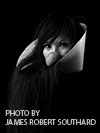 Pyuupiru (Japan, 1974). Lives and works in Tokyo. At the moment, she uses various media: installations, movies, performances, portraiture and sculpture. She works with opposed concepts like life-death, men-women, one-other. She participated in many exhibitions and performances, also on an international level. Besides being a contemporary artist, she works in a wide range of fields like art direction, character design, costume design and writing. You can see more of her work on: pyuupiru.com.
Pyuupiru (Japan, 1974). Lives and works in Tokyo. At the moment, she uses various media: installations, movies, performances, portraiture and sculpture. She works with opposed concepts like life-death, men-women, one-other. She participated in many exhibitions and performances, also on an international level. Besides being a contemporary artist, she works in a wide range of fields like art direction, character design, costume design and writing. You can see more of her work on: pyuupiru.com.The search of an ideal self
by Annemarie Bas
Speaking of the theme of this issue, Liquid Identity, one could say Pyuupiru is its embodiment. She was born as a male, but gradually realised that she didn’t feel comfortable with her body. She started wearing eccentric costumes that distorted her figure. And in 2007 she decided to take it a step further and get sex reassignment surgery, an experience that inspired her Self-portrait Series.
Identity, for Pyuupiru, is something that is constantly being developed and changed. In an interview she said:
“As time goes by, we grow both qualitatively and quantitatively, expanding our capacity. We continue to add various elements and new points of view to our personality, until we are like a bunch of grapes. I think this is the life of people from birth to death.”1
In this way, identity is not a fixed quality, one is constantly adding new elements to one’s personality, moulding it, giving it a new shape, perfecting it, searching for an ideal self. This process is not limited to the mind. The body can also be reshaped, so that it is in harmony with one’s identity.
Pyuupiru described the relationship between body and identity as follows:
“For me, the body is like a vase made of fragile glass. Liquid is an emotion of various colours poured in the vase, and identity is a will to make one pour the liquid into it. You know that the glass changes its shape when heat is added. And you know you choose what you wear by your will. Just like that I’ve transformed my body by my will, both internally and externally. It required me to reveal my very emotion. Emotion is just like a heat having various temperatures, and everyone has it.”2
The discord between body and mind, that Pyuupiru had felt since childhood, has been an incentive for her to make art. In her artistic work, her life experiences and emotions are vital. She keeps them bottled inside of her until they boil, provoking a creative explosion which is then transformed into art.
When she made the Self-portrait Series, she thought of the oppression she felt due to her gender dilemmas: first she thought of her memories and experiences of pain, such as her memories of boyhood and the nightmares caused by hormone replacement therapy and psychoactive drugs. She focused on them up to the point where she felt she had re-lived the suffering enough. Then she filtered those memories and experiences through her sense of beauty in order to be able to shape the characters in her work from the inside and the outside. After that, Pyuupiru, photographed and materialised these characters.
The result is a series of self-portraits which are very intense and personal (despite the fact that in some of the portraits she hides her face with cosmetics, wigs and masks). Exposing her true identity in this way, Pyuupiru tells us, came with a heavy price. Even so, she feels that an artist can gain a pleasure from this exploration that is beyond its costs. Therefore she will certainly continue to share her experiences and feelings through her art in a constant quest to come to grips with the mystery of identity.
1. Fleur Pierets, Pyuupiru in: Et Alors? Magazine, magazine special: GenderBlender (jun.-ago. 2014) 32-39, p.39.
http://issuu.com/etalorsmagazinespecials/docs/genderblender_issuu
2. Owen Leong, Interview with Pyuupiru in: Peril, Asian-Australian Arts and Culture, no. 8 - Why are people so unkind? (nov. 2009).
http://peril.com.au/back-editions/edition08/interview-with-pyuupiru/
 Annemarie Bas (The Netherlands, 1986), has a Bachelor’s degree in History at the University of Utrecht and a Master’s degree in Cultural History at the same institution. As a historian, she worked as a junior researcher at the Museum of Psychiatry "Het Dolhuys" in Haarlem, The Netherlands. Since 2013, she lives and works in Mexico City. At the moment, she is international liaison at ZoneZero and works as an independent translator.
Annemarie Bas (The Netherlands, 1986), has a Bachelor’s degree in History at the University of Utrecht and a Master’s degree in Cultural History at the same institution. As a historian, she worked as a junior researcher at the Museum of Psychiatry "Het Dolhuys" in Haarlem, The Netherlands. Since 2013, she lives and works in Mexico City. At the moment, she is international liaison at ZoneZero and works as an independent translator.







































 Pyuupiru (Japan, 1974). Lives and works in Tokyo. At the moment, she uses various media: installations, movies, performances, portraiture and sculpture. She works with opposed concepts like life-death, men-women, one-other. She participated in many exhibitions and performances, also on an international level. Besides being a contemporary artist, she works in a wide range of fields like art direction, character design, costume design and writing. You can see more of her work on: pyuupiru.com.
Pyuupiru (Japan, 1974). Lives and works in Tokyo. At the moment, she uses various media: installations, movies, performances, portraiture and sculpture. She works with opposed concepts like life-death, men-women, one-other. She participated in many exhibitions and performances, also on an international level. Besides being a contemporary artist, she works in a wide range of fields like art direction, character design, costume design and writing. You can see more of her work on: pyuupiru.com.Adriana Raggi
Throughout the history of art, humans have persistently looked at themselves, leading us all to perceive ourselves in an image that is repeated ad nauseam, yet is at the same time entirely essential. During earlier periods of art, whose productions are assumed to be of particular clarity, the self-portrait existed as a form enabling the artist to stand before others and declare who they were. Today, a complex process is taking place and we can therefore not call it self-portraiture, but seek other names, the most common being self-representation.
1.
Regardless of how we refer to it, a moment occurs in representation in which the artist carries out a performative act, in which he sees himself, which entails identification with the spectator. This action involves questioning the audience, the artist and the medium employed. One specific example is the key moment in Cris Birrenbach’s work Identidade, when he destroys himself before the camera, before us, to show us that gender and beauty can be referred to both playfully and violently, and that gender is merely a social construct achieved through performance. We act it out and repeat it, and in the same vein Birrenbach carries out an action before us which involves removing his gender and putting it on. He adopts it, discards it and then takes it up again. We are his mirror. We see him in this process of destruction, and feel strongly attracted to the image of a practice that we have undergone without realizing.
Identidade by Cris Bierrenbach
2.
On the other side of the mirror is Nicola Costantino, in her work Unfinished Rhapsody. In this video-installation presented at the Venice Biennial and embroiled in political controversy – when the Argentinian government wished to give it its own ending1 Argentina’s collective memory to bring us an intimate Evita, who is Eva and yet Nicola. In this work, self-representation is a form of self-destruction and reconstruction of the image of herself and of a historical icon of modern Argentina. It is a mise en scène, a performative construction of the artist’s body within Evita’s body. Costantino uses technology to reconstruct, through scenography and video, the history of the appliance that Eva allegedly used to support her sick body during her last public appearance. This was an Eva striving to maintain an image of strength. Meanwhile, Nicola’s body reveals a wound and a mystery.
Unfinished Rhapsody by Nicola Costantino
3.
The mystery of Eva is encapsulated in the work Meshes of the Afternoon by Maya Deren, in which the artist uses her image repeatedly, thus confronting us with episodes from our daily life and psyche and placing us in terrifyingly familiar spaces. Deren is pursuing a mysterious figure to find herself over and over again. The representations of Maya are ominous yet sumptuously beautiful. They remind us that we are only here for an instant.
Meshes of the Afternoon by Maya Deren
Final
When Guillermo Gómez Peña looks at us in his video performance To Death (Second duel), he says: “I have a surprise for you”, and from that moment onwards a mise en scène begins that enables us to understand the performance. Several questions remain unanswered. He puts on his body, as do Bierrenbach, Costantino and Deren. Here, his body is a self-representation but also a teaching tool. In his hands he holds a gun, the most powerful of tools. He aims it at us and shows us directly what all the other works have subtly demonstrated . A performative self-representation comments on the human being itself, and confronts us with what we are and are not. When we see Deren looking at herself, Bierrenbach destroying himself through violence, Costantino constructing herself in the body of another person, and finally, Gómez Peña aiming a gun at us, we realize that we are viewing out own finitude and fragility. What we are and do is determined by time, by the wound of knowing that we are going to die, the fragility of flesh and the absurd captivity of social limitations. At that moment, we can see each and every one of us.
To Death by Guillermo Gómez Peña
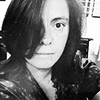 Adriana Raggi (Mexico, 1970). Lives and works in Mexico. She has a Bachelor’s degree in Visual Arts at the National School of Plastic Arts and a Master’s degree and Doctorate in Art History at the Faculty of Philosophy and Literature, UNAM. She also followed the program Photo Narrative and New Media at the Pedro Meyer Foundation. She is professor at the National School of Plastic Arts and a member of the collective Las Disidentes. She has exhibited her work in Mexico and the United States, and also participated in more than twenty collective exhibitions. To see more of her work go to: www.adrianaraggi.net
Adriana Raggi (Mexico, 1970). Lives and works in Mexico. She has a Bachelor’s degree in Visual Arts at the National School of Plastic Arts and a Master’s degree and Doctorate in Art History at the Faculty of Philosophy and Literature, UNAM. She also followed the program Photo Narrative and New Media at the Pedro Meyer Foundation. She is professor at the National School of Plastic Arts and a member of the collective Las Disidentes. She has exhibited her work in Mexico and the United States, and also participated in more than twenty collective exhibitions. To see more of her work go to: www.adrianaraggi.net[core_state] => 1 [core_access] => 1 [core_metadata] => {"robots":"","author":"Adriana Raggi","rights":"","xreference":""} [core_created_user_id] => 841 [core_created_by_alias] => [core_created_time] => 2014-06-20 17:00:00 [core_images] => {"image_intro":"images\/categories\/liquididentity\/raggi.jpg","float_intro":"","image_intro_alt":"","image_intro_caption":"","image_fulltext":"images\/categories\/liquididentity\/raggi.jpg","float_fulltext":"","image_fulltext_alt":"","image_fulltext_caption":""} [core_modified_time] => 2015-09-30 17:48:39 [core_language] => en-GB [core_catid] => 47 [core_publish_up] => 2014-06-20 17:00:00 [core_publish_down] => 0000-00-00 00:00:00 [content_type_title] => Article [router] => ContentHelperRoute::getArticleRoute [author] => [author_email] => [link] => index.php?option=com_content&view=article&id=185:self-representation-and-mystery&catid=47&lang=en-GB [displayDate] => 2014-06-20 17:00:00 [event] => stdClass Object ( [afterDisplayTitle] => [beforeDisplayContent] => [afterDisplayContent] => ) [text] =>
Throughout the history of art, humans have persistently looked at themselves, leading us all to perceive ourselves in an image that is repeated ad nauseam, yet is at the same time entirely essential. During earlier periods of art, whose productions are assumed to be of particular clarity, the self-portrait existed as a form enabling the artist to stand before others and declare who they were. Today, a complex process is taking place and we can therefore not call it self-portraiture, but seek other names, the most common being self-representation.
1.
Regardless of how we refer to it, a moment occurs in representation in which the artist carries out a performative act, in which he sees himself, which entails identification with the spectator. This action involves questioning the audience, the artist and the medium employed. One specific example is the key moment in Cris Birrenbach’s work Identidade, when he destroys himself before the camera, before us, to show us that gender and beauty can be referred to both playfully and violently, and that gender is merely a social construct achieved through performance. We act it out and repeat it, and in the same vein Birrenbach carries out an action before us which involves removing his gender and putting it on. He adopts it, discards it and then takes it up again. We are his mirror. We see him in this process of destruction, and feel strongly attracted to the image of a practice that we have undergone without realizing.
Identidade by Cris Bierrenbach
2.
On the other side of the mirror is Nicola Costantino, in her work Unfinished Rhapsody. In this video-installation presented at the Venice Biennial and embroiled in political controversy – when the Argentinian government wished to give it its own ending1 Argentina’s collective memory to bring us an intimate Evita, who is Eva and yet Nicola. In this work, self-representation is a form of self-destruction and reconstruction of the image of herself and of a historical icon of modern Argentina. It is a mise en scène, a performative construction of the artist’s body within Evita’s body. Costantino uses technology to reconstruct, through scenography and video, the history of the appliance that Eva allegedly used to support her sick body during her last public appearance. This was an Eva striving to maintain an image of strength. Meanwhile, Nicola’s body reveals a wound and a mystery.
Unfinished Rhapsody by Nicola Costantino
3.
The mystery of Eva is encapsulated in the work Meshes of the Afternoon by Maya Deren, in which the artist uses her image repeatedly, thus confronting us with episodes from our daily life and psyche and placing us in terrifyingly familiar spaces. Deren is pursuing a mysterious figure to find herself over and over again. The representations of Maya are ominous yet sumptuously beautiful. They remind us that we are only here for an instant.
Meshes of the Afternoon by Maya Deren
Final
When Guillermo Gómez Peña looks at us in his video performance To Death (Second duel), he says: “I have a surprise for you”, and from that moment onwards a mise en scène begins that enables us to understand the performance. Several questions remain unanswered. He puts on his body, as do Bierrenbach, Costantino and Deren. Here, his body is a self-representation but also a teaching tool. In his hands he holds a gun, the most powerful of tools. He aims it at us and shows us directly what all the other works have subtly demonstrated . A performative self-representation comments on the human being itself, and confronts us with what we are and are not. When we see Deren looking at herself, Bierrenbach destroying himself through violence, Costantino constructing herself in the body of another person, and finally, Gómez Peña aiming a gun at us, we realize that we are viewing out own finitude and fragility. What we are and do is determined by time, by the wound of knowing that we are going to die, the fragility of flesh and the absurd captivity of social limitations. At that moment, we can see each and every one of us.
To Death by Guillermo Gómez Peña
 Adriana Raggi (Mexico, 1970). Lives and works in Mexico. She has a Bachelor’s degree in Visual Arts at the National School of Plastic Arts and a Master’s degree and Doctorate in Art History at the Faculty of Philosophy and Literature, UNAM. She also followed the program Photo Narrative and New Media at the Pedro Meyer Foundation. She is professor at the National School of Plastic Arts and a member of the collective Las Disidentes. She has exhibited her work in Mexico and the United States, and also participated in more than twenty collective exhibitions. To see more of her work go to: www.adrianaraggi.net
Adriana Raggi (Mexico, 1970). Lives and works in Mexico. She has a Bachelor’s degree in Visual Arts at the National School of Plastic Arts and a Master’s degree and Doctorate in Art History at the Faculty of Philosophy and Literature, UNAM. She also followed the program Photo Narrative and New Media at the Pedro Meyer Foundation. She is professor at the National School of Plastic Arts and a member of the collective Las Disidentes. She has exhibited her work in Mexico and the United States, and also participated in more than twenty collective exhibitions. To see more of her work go to: www.adrianaraggi.net[id] => 185 [language] => en-GB [catid] => 47 [jcfields] => Array ( ) ) 1
ZoneZero

Considered a visual artist, interactive narrator and Internet anthropologist, Harris is interested in the fragments and feelings of intimate stories, and our need to express ourselves. He converses with the viewer through images and technology, interconnected them to his own artistic universe.
In his essay Navigating Stuckness, which consists of texts and illustrations, Harris shares an autobiographical journey, describing the successive stages of his development as a creator and how he has forced himself to surpass and rediscover himself. ZoneZero has chosen two projects from these various stages, to present a sample of the enormous variety and diversity of his platforms of expression, as a glimpse of his versatile artwork.
The first is Today, photographs documenting the 440 days that followed Harris’s 30th birthday, defining a self-portrait of his everyday life and transforming this process into a ritual. In the second, Balloons of Buthan, he presents portraits of happiness in the last Himalayan kingdom, Bhutan. He uses photographs and audio testimonials to address universal concerns, and records action through an interactive platform in which we can approach each of the 117 persons he met.
These are only two examples, showing two principal lines of Harris’s artistic activity. One of these is realizing that in order to approach other people and depend on them, we must pause to know and speak about ourselves. The other line is interpreting how we can converge with technology as the best means of telling stories, thus creating platforms that give order to human chaos in our globalized, Internet-centered world.
Harris is perhaps one of the most sensitive artists present online, whose projects can inspire us to continue our own pursuit of visual communication. The ZoneZero team therefore presents an interview with him, to provide an insight into the processes involved in his work.
 Jonathan Harris (USA, 1979). Lives and works in New York, though he undertakes some of his projects in others parts of the world. Balloons of Buthan, for example, was produced in Buthan, Himalaya. An artist and computer scientist, his work explores the relationship between humans and technology. He graduated in Computer Science and Photography from Princeton University. His artwork has been exhibited throughout the world and has earned several prizes and awards. It can be viewed at: Number27
Jonathan Harris (USA, 1979). Lives and works in New York, though he undertakes some of his projects in others parts of the world. Balloons of Buthan, for example, was produced in Buthan, Himalaya. An artist and computer scientist, his work explores the relationship between humans and technology. He graduated in Computer Science and Photography from Princeton University. His artwork has been exhibited throughout the world and has earned several prizes and awards. It can be viewed at: Number27Regarding the development of your projects, could you tell us what's the place of the concept and what role does your selected media play?
For me, projects tend to start with a concept — usually something simple and communicable in a single sentence (e.g. “A search engine for feelings” (We Feel Fine), “A public library of human experience” (Cowbird), “An expression of single moments in time” (10x10). From there, I spend a lot of time developing the idea on paper (in my sketchbook). This process is iterative, and can take a long time. I’ll usually try a lot of different angles and approaches, and many of them won’t feel right, so I’ll keep trying different things, all the while keeping in mind that single-sentence description, which is like the soul of the idea, and that soul should never change. At some point, I’ll decide on an angle (e.g. search for the phrase “I feel”; constrain stories to text and a single image; scrape news websites every hour for 100 words and pictures; etc.), and will start collecting data. Then, there's the process of developing a relationship with that data, which is almost like learning the ways of a lover — to try to understand its secrets (i.e. what about it is beautiful and interesting). Once you learn its secrets, then you can design interfaces that reveal those secrets to others. That is what makes something feel poetic, and what makes it come alive.
On your most recent work, what are the topics or concerns that move you to start and develop a new project?
Currently, I’m interested in the evolution of the human species into a single meta-organism, in which we all take part, like cells in a body. I’m interested in the nature of that meta-organism — its emotions, its thoughts, its desires, its choices.
With the constant changes on technology and projects that rely so much on it, do you worry about obsolescence? How do you deal with that risk?
Working with technology, obsolescence is unavoidable. Already, some of my earlier projects are difficult or impossible to see — most browsers no longer support Java applets by default, so to view We Feel Fine, visitors must download and install a plugin; the company whose news API powered Universe was acquired and no longer exists, so that project is sadly offline. Nowadays, I try to use open source technologies (HTML5, Javascript, WebGL, etc.), which are less likely to become obsolete than proprietary technologies like Java and Flash.
On an aesthetic level, obsolescence is also a danger, but this kind of obsolescence is related to the homogenizing effect of popular tools. For instance, when many people use a tool like Adobe Illustrator, Adobe Flash, or even a service like Instagram, the shortcuts enabled by the tool will, over time, have a homogenizing effect on the projects that people use the tool to create. Because of this, many digital projects quickly look dated — they are timely, but not timeless. To avoid this, I try to design all my interfaces from scratch, not relying on shortcuts enabled by tools, but generated programmatically by code I write myself. So, for example, the typography in The Whale Hunt is custom-designed to be bisected by whaling harpoons. In Universe, all the typography is formed by star constellations. When you write stuff from scratch (using open source tools), you have a better chance at avoiding obsolescence.
You can learn more about Harris's concerns and obsessions by visiting number27.org

Considered a visual artist, interactive narrator and Internet anthropologist, Harris is interested in the fragments and feelings of intimate stories, and our need to express ourselves. He converses with the viewer through images and technology, interconnected them to his own artistic universe.
In his essay Navigating Stuckness, which consists of texts and illustrations, Harris shares an autobiographical journey, describing the successive stages of his development as a creator and how he has forced himself to surpass and rediscover himself. ZoneZero has chosen two projects from these various stages, to present a sample of the enormous variety and diversity of his platforms of expression, as a glimpse of his versatile artwork.
The first is Today, photographs documenting the 440 days that followed Harris’s 30th birthday, defining a self-portrait of his everyday life and transforming this process into a ritual. In the second, Balloons of Buthan, he presents portraits of happiness in the last Himalayan kingdom, Bhutan. He uses photographs and audio testimonials to address universal concerns, and records action through an interactive platform in which we can approach each of the 117 persons he met.
These are only two examples, showing two principal lines of Harris’s artistic activity. One of these is realizing that in order to approach other people and depend on them, we must pause to know and speak about ourselves. The other line is interpreting how we can converge with technology as the best means of telling stories, thus creating platforms that give order to human chaos in our globalized, Internet-centered world.
Harris is perhaps one of the most sensitive artists present online, whose projects can inspire us to continue our own pursuit of visual communication. The ZoneZero team therefore presents an interview with him, to provide an insight into the processes involved in his work.
 Jonathan Harris (USA, 1979). Lives and works in New York, though he undertakes some of his projects in others parts of the world. Balloons of Buthan, for example, was produced in Buthan, Himalaya. An artist and computer scientist, his work explores the relationship between humans and technology. He graduated in Computer Science and Photography from Princeton University. His artwork has been exhibited throughout the world and has earned several prizes and awards. It can be viewed at: Number27
Jonathan Harris (USA, 1979). Lives and works in New York, though he undertakes some of his projects in others parts of the world. Balloons of Buthan, for example, was produced in Buthan, Himalaya. An artist and computer scientist, his work explores the relationship between humans and technology. He graduated in Computer Science and Photography from Princeton University. His artwork has been exhibited throughout the world and has earned several prizes and awards. It can be viewed at: Number27Regarding the development of your projects, could you tell us what's the place of the concept and what role does your selected media play?
For me, projects tend to start with a concept — usually something simple and communicable in a single sentence (e.g. “A search engine for feelings” (We Feel Fine), “A public library of human experience” (Cowbird), “An expression of single moments in time” (10x10). From there, I spend a lot of time developing the idea on paper (in my sketchbook). This process is iterative, and can take a long time. I’ll usually try a lot of different angles and approaches, and many of them won’t feel right, so I’ll keep trying different things, all the while keeping in mind that single-sentence description, which is like the soul of the idea, and that soul should never change. At some point, I’ll decide on an angle (e.g. search for the phrase “I feel”; constrain stories to text and a single image; scrape news websites every hour for 100 words and pictures; etc.), and will start collecting data. Then, there's the process of developing a relationship with that data, which is almost like learning the ways of a lover — to try to understand its secrets (i.e. what about it is beautiful and interesting). Once you learn its secrets, then you can design interfaces that reveal those secrets to others. That is what makes something feel poetic, and what makes it come alive.
On your most recent work, what are the topics or concerns that move you to start and develop a new project?
Currently, I’m interested in the evolution of the human species into a single meta-organism, in which we all take part, like cells in a body. I’m interested in the nature of that meta-organism — its emotions, its thoughts, its desires, its choices.
With the constant changes on technology and projects that rely so much on it, do you worry about obsolescence? How do you deal with that risk?
Working with technology, obsolescence is unavoidable. Already, some of my earlier projects are difficult or impossible to see — most browsers no longer support Java applets by default, so to view We Feel Fine, visitors must download and install a plugin; the company whose news API powered Universe was acquired and no longer exists, so that project is sadly offline. Nowadays, I try to use open source technologies (HTML5, Javascript, WebGL, etc.), which are less likely to become obsolete than proprietary technologies like Java and Flash.
On an aesthetic level, obsolescence is also a danger, but this kind of obsolescence is related to the homogenizing effect of popular tools. For instance, when many people use a tool like Adobe Illustrator, Adobe Flash, or even a service like Instagram, the shortcuts enabled by the tool will, over time, have a homogenizing effect on the projects that people use the tool to create. Because of this, many digital projects quickly look dated — they are timely, but not timeless. To avoid this, I try to design all my interfaces from scratch, not relying on shortcuts enabled by tools, but generated programmatically by code I write myself. So, for example, the typography in The Whale Hunt is custom-designed to be bisected by whaling harpoons. In Universe, all the typography is formed by star constellations. When you write stuff from scratch (using open source tools), you have a better chance at avoiding obsolescence.
You can learn more about Harris's concerns and obsessions by visiting number27.org

